



































3,200/page RM 3,200/page
Full-Page, Full-Colour Advertisement
This one-time-only special rate o er is for new advertisers.
Space availability is subject to booking on a first-come-first-served basis.
Clients will provide ready-to-print artwork in PDF format with 300dpi.
Full page: 210mm x 285mm, 5mm extra bleed sizes for 4-sided with crop mark.
Advertising space must be utilised before 31 December 2023.
*Please note that the above rate will be subjected to 6% SST. For overseas advertisers, an additional 25% will be charged.
Rate shown above excludes 15% advertising agency commission.
Payment term: Full advance payment.
Artwork submission deadline is on (or before) the 1st week of the prior month of publication. After the material deadline, no cancellation or alteration to the advertisement will be entertained.
Any cancellation after signing the advertising order will result in a 50% penalty charge. The publisher reserves the right to edit, revise or reject any advertisement deemed unsuitable or inappropriate.
JURUTERA has an estimated readership of 200,000 professionals. Our esteemed readership consists of certi ed engineers, decision making corporate leaders, CEOs, government o cials, project directors, entrepreneurs, project consultants, engineering consulting rms and companies involved with engineering products and services. Circulation & Readership Pro le

MAJLIS BAGI SESI 2023/2024 (IEM COUNCIL SESSION 2023/2024)
YANG DIPERTUA / PRESIDENT
Ir. Prof. Dr Norlida bt Buniyamin
TIMBALAN YANG DIPERTUA / DEPUTY PRESIDENT
Ir. Prof. Dr Jeffrey Chiang Choong Luin
NAIB YANG DIPERTUA / VICE PRESIDENTS
Ir. Mohd Khir bin Muhammad, Ir. Ts. Prof. Dr Tan Chee Fai, Ir. Abdul Razak bin Yakob,
Ir. Yau Chau Fong, Ir. Dr Siti Hawa binti Hamzah, Ir. Fam Yew Hin, Ir. Chen Harn Shean
SETIAUSAHA KEHORMAT / HONORARY SECRETARY
Ir. Prof. Dr Zuhaina binti Zakaria
BENDAHARI KEHORMAT / HONORARY TREASURER
Ir. Assoc. Prof. Dr David Chuah Joon Huang
BEKAS YANG DIPERTUA TERAKHIR / IMMEDIATE PAST PRESIDENT
Ir. Ong Ching Loon
BEKAS YANG DIPERTUA / PAST PRESIDENTS
Y.Bhg. Academician Tan Sri Datuk Ir. (Dr) Ahmad Zaidee bin Laidin, Y.Bhg. Dato’ Paduka Ir. Hj. (Dr)
Keizrul bin Abdullah, Y.Bhg. Tan Sri Dato’ Seri Academician Ir. Professor Emeritus Dr Chuah Hean Teik, Y.Bhg. Dato’ Ir. Lim Chow Hock, Ir. Dr Tan Yean Chin
WAKIL AWAM / CIVIL REPRESENTATIVE
Ir. Tu Yong Eng
WAKIL MEKANIKAL / MECHANICAL REPRESENTATIVE
Ir. Ng Yong Kong
WAKIL ELEKTRIK / ELECTRICAL REPRESENTATIVE
Ir. Mohd. Aman bin Hj. Idris
WAKIL STRUKTUR / STRUCTURAL REPRESENTATIVE
Ir. Dr Tan Kuang Leong
WAKIL KIMIA / CHEMICAL REPRESENTATIVE
Ir. Dr Chong Chien Hwa
WAKIL LAIN-LAIN DISPLIN / REPRESENTATIVE TO OTHER DISCIPLINES
Ir. Assoc. Prof. Dr Wong Yew Hoong
WAKIL MULTIMEDIA DAN ICT / ICT AND MULTIMEDIA REPRESENTATIVE
Ir. Assoc. Prof. Dr Lai Khin Wee
WAKIL JURUTERA WANITA / WOMEN ENGINEERS REPRESENTATIVE
Ir. Noorfaizah binti Hamzah
WAKIL BAHAGIAN JURUTERA SISWAZAH / YOUNG ENGINEERS SECTION REPRESENTATIVES
Mr. Muhammad Ashiq Marecan bin Hamid Marecan, Grad. IEM, Mr. Lim Yiren, Mr. Darshan a/l Balasubramaniam, Grad. IEM, Mr. Ooi Wei Chien, Grad. IEM, Ms. Ong Ye Shian, Grad. IEM AHLI - AHLI MAJLIS / COUNCIL MEMBERS
Ir. Dr Vigna Kumaran a/l Ramachandaramurthy (casual vacancy for Ir. Dr Siti Hawa binti Hamzah for 1 session), Ir. Assoc. Prof. Dr Lee Tin Sin, Ir. Mah Way Sheng, Ir. Sreedaran Raman, Ir. Lee Cheng Pay, Ir. Dr Kannan a/l M. Munisamy, Ir. Dr Siow Chun Lim, Ir. Wong Chee Fui, Ir. Ts. Assoc. Prof. Dr Hum Yan Chai, Ir. Tiong Ngo Pu, Ir. Rusnida binti Talib, Ir. Prof. Dr Lau Hieng Ho, Ir. Dr Muhammad Azmi bin Ayub, Ir. Arul Hisham bin Abdul Rahim (casual vacancy for Ir. Fam Yew Hin - for 2 sessions), Ir. Razmahwata bin Mohd Razalli, Ir. Simon Yeong Chin Chow, Ir. Dr Chan Seong Phun, Ir. Yam Teong Sian, Ir. Kwok Yew Hoe, Ir. Dr Lee Choo Yong, Ir. Sharifah Azlina binti Raja Kamal Pasmah, Ir. Ts. Dr Wan Syakirah binti Wan Abdullah, Ir. Dr Mui Kai Yin, Ir. Shamil bin Abu Hassan, Ir. Wan Rizaluddin Abdullah bin Wan Ali, Ir. Prof. Dr Lam Wei Haur (casual vacancy for Ir. Prof. Dr Zuhaina bt Zakaria for 3 sessions) AHLI - AHLI MAJLIS JEMPUTAN / COUNCIL MEMBERS BY INVITATION
Ir. Lai Sze Ching, Ir. Gopal Narian Kutty, Y.Bhg. Dato’ Prof. Ir. Dr Mohd Hamdi bin Abd Shukor PENGERUSI CAWANGAN / BRANCH CHAIRMAN
1. Pulau Pinang: Ir. Chan Wah Cheong
2. Selatan: Ir. Thayala Rajah s/o Selvaduray
3. Perak: Ir. Assoc. Prof. Dr Nursyarizal bin Mohd Nor 4. Pahang: Ir. Ab Rahman bin Hashim
5. Kedah-Perlis: Ir. Roshasmawi bin Abdul Wahab
6. Negeri Sembilan: Ir. Shahrin Amri bin Jahari
7. Kelantan: Ir. Ts. Hj. Abrizan bin Abdul Kadir
8. Terengganu: Ir. Mazlan bin Che Ku Ahmad
9. Melaka: Ir. Ong Yee Pinn
10. Sarawak: Ir. Sim Hui Kheng, Stephanie
11. Sabah: Ir. Chin Tet Fu, Willy
12. Miri: Ir. Chong Boon Hui
AHLI JAWATANKUASA INFORMASI DAN PENERBITAN/ STANDING COMMITTEE ON INFORMATION AND PUBLICATIONS 2023/2024
Pengerusi/Chairman: Ir. Abdul Razak bin Yakob Naib Pengerusi/Vice Chairman: Ir. Dr Siow Chun Lim Setiausaha/Secretary: Ir. Ts. Assoc. Prof. Dr Hum Yan Chai Ketua Pengarang/Chief Editor: Ir. Abdul Razak bin Yakob Pengarang Prinsipal Buletin/ Principal Bulletin Editor: Ir. Razmahwata bin Mohamad Razalli Pengarang Prinsipal Jurnal/Principal Journal Editor: Ir. Ts. Assoc. Prof. Dr Teo Fang Yenn Pengerusi Aplikasi Mudah Alih IEMGo/IEMGo Mobile Application Chairman: Ir. Dr Bhuvendhraa Rudrusamy Pengerusi Penglibatan Ahli/Members Engagement Chairperson: Ir. Rusnida binti Talib Pengerusi Pusat Sumber/Resource Centre Chairman: Ir. Dr Kannan a/l M. Munisamy
Ahli-Ahli/Committee Members: Ir. Ong Guan Hock, Ir. Lee Chang Quan, Ir. Lau Tai Onn, Ir. Dr Oh Seong Por, Ir. Yee Thien Seng, Ir. Dr Lee Choo Yong, Ir. Ts. Dr Tan Kim Seah, Ir. Assoc. Prof. Dr Lee Tin Sin, Dr Sudharshan N. Raman, Grad. IEM, Ms. Michelle Lau Chui Chui, Grad. IEM, Ir. Tu Yong Eng, Dr Nor Ilia Anisa Aris, Grad. IEM, Mr. Muhd Ashiq Marecan bin Hamid Marecan, Grad. IEM, Mr. Chuah Pei Lim, Grad. IEM
LEMBAGA PENGARANG/EDITORIAL BOARD 2023/2024
Ketua Pengarang/Chief Editor: Ir. Abdul Razak bin Yakob Pengarang Prinsipal Buletin/ Principal Bulletin Editor: Ir. Razmahwata bin Mohamad Razalli Ahli-ahli/Committee Members: Ir. Dr Siow Chun Lim, Ir. Lau Tai Onn, Ir. Ong Guan Hock, Ir. Yee Thien Seng, Ir. Dr Oh Seong Por, Ir. Ts. Assoc. Prof. Dr Teo Fang Yenn, Dr Sudharshan N. Raman, Ir. Tu Yong Eng, Ir. Lee Chang Quan, Ir. Dr Lee Choo Yong, Ir. Ts. Dr Tan Kim Seah, Ms. Michelle Lau Chui Chui, Grad. IEM Secretariat: Janet Lim, Nurul Aida binti Mustafa, Nur Illyarnie binti Rosman
THE INSTITUTION OF ENGINEERS, MALAYSIA Bangunan Ingenieur, Lots 60 & 62, Jalan 52/4, P.O. Box 223, (Jalan Sultan), 46720 Petaling Jaya, Selangor Darul Ehsan. Tel: 603-7968 4001/4002 Fax: 603-7957 7678 E-mail: sec@iem.org.my Homepage: http://www.myiem.org.my
Navigating the Just Energy Transition for Oil & Gas Sector: Moving Forward
Unveiling Hidden Risk of Major Hazard Incidents: Bridging the Gap between Natural Disasters and Industrial Safety
To Blast or Not To Blast?
Distributed Cold Blowdown Analysis With Finite Element Wall Model
Iconic Golden Bridge of Danang, Vietnam
11th Episode of Sembang Chillex at KLCC on 9 September 2023
Empowering Girls in Science: Women in Zcience (WiZ) is Back, Physically!
The 34th International Invention & Innovation Exhibition (ITEX) 2023
Convention - ENGINEER 2023
Safety Essentials: Protecting Lives and the Environment
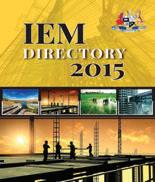
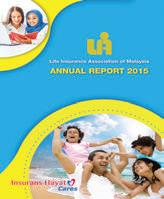







































DIMENSION PUBLISHING SDN. BHD. [ 199701034233 (449732-T) ]
Level 18-01, PJX-HM Shah Tower, No. 16A, Persiaran Barat, 46050 Petaling Jaya, Selangor Darul Ehsan, Malaysia.
Tel: +(603) 7493 1049 Fax: +(603) 7493 1047
E-mail: info@dimensionpublishing.com
Website: www.dimensionpublishing.com
CHAIRMAN
ROBERT MEBRUER
CEO/PUBLISHER
PATRICK LEUNG
GENERAL MANAGER
SHIRLEY THAM ● shirley@dimensionpublishing.com
HEAD OF MARKETING & BUSINESS DEVELOPMENT
JOSEPH HOW ● joseph@dimensionpublishing.com
PRODUCTION EDITOR
TAN BEE HONG ● bee@dimensionpublishing.com
CONTRIBUTING WRITERS
PUTRI ZANINA ● putri@dimensionpublishing.com
HANNA SHEIKH MOKHTAR ● hanna@dimensionpublishing.com
SENIOR GRAPHIC DESIGNER
SOFIA HANIS ● sofia@dimensionpublishing.com
GRAPHIC DESIGNER
NICOLE THENG ● nicole@dimensionpublishing.com
ADVERTISING CONSULTANTS
THAM CHOON KIT ● ckit@dimensionpublishing.com
ACCOUNTS CUM ADMIN EXECUTIVE
YEN YIN ● yenyin@dimensionpublishing.com
For advertisement placements and subscriptions, please contact: DIMENSION PUBLISHING SDN. BHD. [ 199701034233 (449732-T) ]
Level 18-01, PJX-HM Shah Tower, No.16A, Persiaran Barat, 46050 Petaling Jaya, Selangor Darul Ehsan, Malaysia. Tel: +(603) 7493 1049 Fax: +(603) 7493 1047 E-mail: info@dimensionpublishing.com
Subscription Department E-mail: info@dimensionpublishing.com
JURUTERA is published and printed monthly by Dimension Publishing Sdn. Bhd.
JURUTERA MONTHLY CIRCULATION: OVER 50,000 MEMBERS
Submission or placement of articles in JURUTERA could be made to the:Chief Editor
THE INSTITUTION OF ENGINEERS , MALAYSIA (IEM) Bangunan Ingenieur, Lots 60 & 62, Jalan 52/4, P.O. Box 223 (Jalan Sultan), 46720 Petaling Jaya, Selangor. Tel: +(603) 7968 4001/4002 Fax: +(603) 7957 7678 E-mail: pub@iem.org.my or sec@iem.org.my IEM Website: http://www.myiem.org.my
© 2023, The Institution of Engineers, Malaysia (IEM) and Dimension Publishing Sdn. Bhd.
PUBLICATION DISCLAIMER
The publication has been compiled by both IEM and Dimension with great care and they disclaim any duty to investigate any products, process, services, designs and the like which may be described in this publication. The appearance of any information in this publication does not necessarily constitute endorsement by IEM and Dimension. There is no guarantee that the information in this publication is free from errors. IEM and Dimension do not necessarily agree with the statement or the opinion expresssed in this publication.
COPYRIGHT
JURUTERA Bulletin of IEM is the official magazine of The Institution of Engineers, Malaysia (IEM) and is published by Dimension Publishing Sdn. Bhd. The Institution and the Publisher retain the copyright over all materials published in the magazine. No part of this magazine may be reproduced and transmitted in any form or stored in any retrieval system of any nature without the prior written permission of IEM and the Publisher.

by Ir. Lee Chang Quan Chairman, Oil, Gas & Mining Technical Division
At the 2019 United Nations Climate Action Summit at New York, Greta Thunberg, then a 16-year-old Swedish girl, made a roaring speech, exclaiming “How dare you...” and demanded that world leaders put words into real action in combating the climate change. Three years have passed and there have been three United Nations Climate Change Conferences (also known as COP) held separately in Madrid, Glasgow, Cairo.
The world has changed much with new geopolitical risks at play, especially the Ukraine crisis. While some countries have accelerated growth in renewable energy, some have reviewed their energy policy with the growing concern over energy security amidst the energy supply risk. The oil and gas industry remains in the hot seat. There is a growing demand for the industry to do more and act faster to reduce emissions or even to switch to alternative energy sources.
In this issue of JURUTERA, the Oil, Gas and Mining Technical Division (OGMTD) will address this issue by sharing views from industry players in managing the Environmental, Social, Governance (ESG) risks. Meanwhile, COP28 will be held soon in Dubai, UAE, on 30 November to 12 December 2023 and it will be most interesting to know the outcome.
Whether you are in the O&G industry or not, engineers should contribute to the country’s aspiration of net-zero carbon emissions by year 2050, as well as the success of the newly-launched National Energy Transition Roadmap. Stay tuned!
by Ir. Razmahwata bin Mohamad Razalli Principal Bulletin Editor
“Neither Snow nor Rain nor Heat nor Gloom of Night…”
The most battlehardened team in IEM is without doubt, the Membership Department. This is the team that has, many a time, faced the irate blast of members. Nonetheless, the 10 Secretariat staff members who make up this team still endeavour to maintain a smile and a cordial response. They diligently handle membership processing, conduct examinations, qualifications checking, CPD evaluation, membership drive and recruitment as well as administer IEM Structured Training and Logbook Scheme.
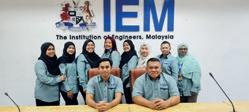
Membership Department
In 2022, they processed a total of 4,066 applications for IEM membership, 346 IEM Professional Interviews, approximately 200 PAE cases and numerous membership recruitment exercises at IHLs and exhibitions among other functions. We greatly appreciate their contributions to the growth of membership in IEM.
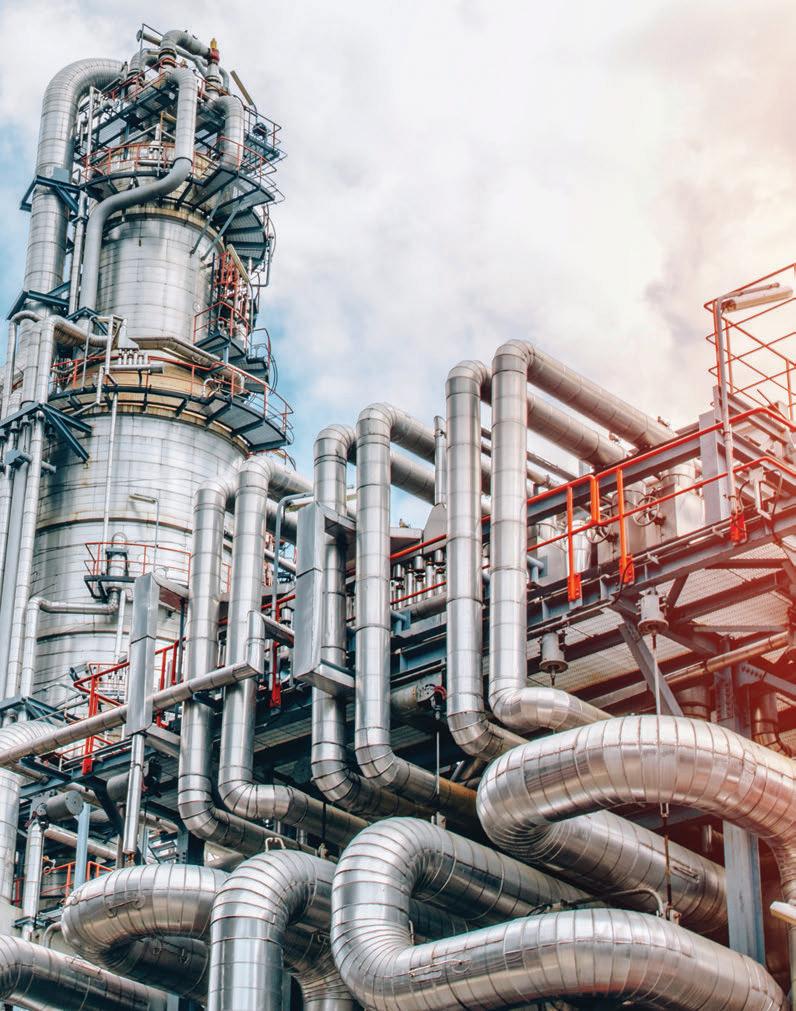
As climate awareness gains momentum globally, the imperative to address climate change has cast its spotlight on the oil and gas (O&G) industry. Amid mounting pressure for O&G companies to decarbonise their operations and embrace low-carbon solutions, JURUTERA talks to Puan Nurzalina binti Jamaluddin, Vice President of Low Carbon Ventures at Hibiscus Petroleum Berhad. This insightful dialogue delves into the complexities, challenges and opportunities that shape the O&G sector as it navigates the path toward sustainability.
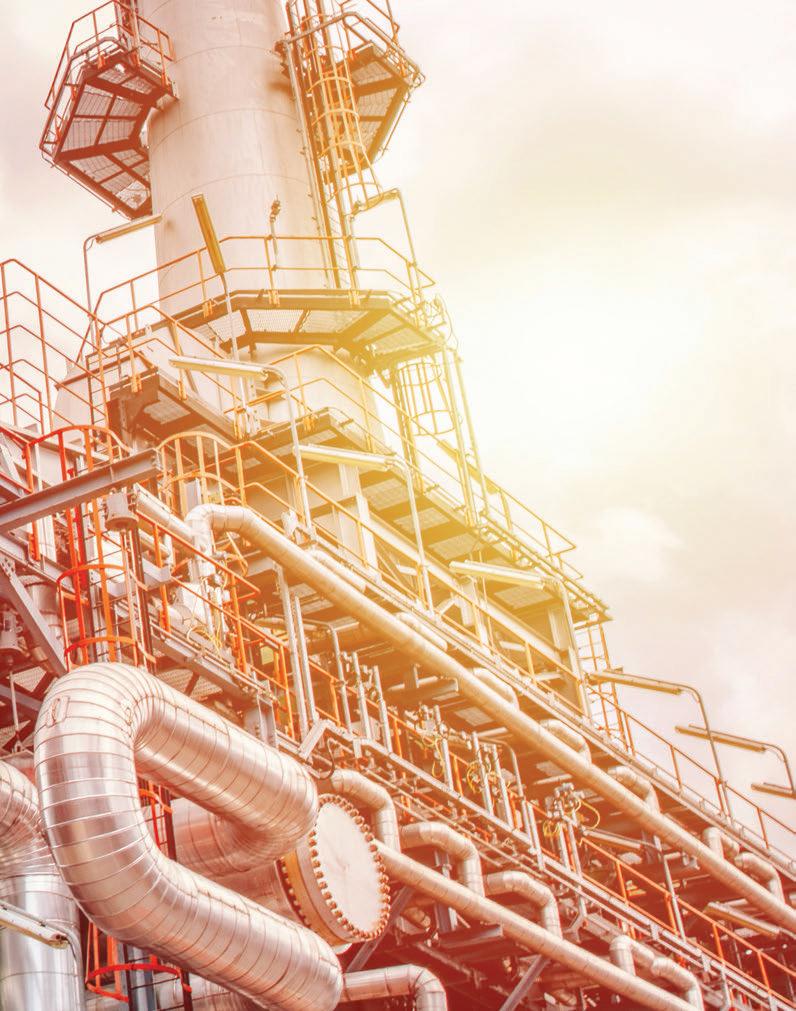
The global shift towards recognising the urgency of climate change places greater expectations on the energy industry to drive initiatives that mitigate greenhouse gas emissions (GHG). In Malaysia, the energy sector contributes approximately 78% of the GHG emission in Malaysia*. A significant driver for change comes from the Malaysian Government’s ambitious target to achieve net zero emissions by 2050, a goal articulated in the National Energy Transition Roadmap launched in July this year. This ambitious aspiration underscores the importance of getting the support of O&G companies in attaining the national objective.
Part of this transition involves a pronounced emphasis on renewable energy as a cornerstone of Malaysia’s energy system. With the Ministry of Economy announcing a target of 70% renewable energy in the power mix by 2050, the country is positioning itself to simultaneously fuel economic growth and combat climate change.
Puan Zalina advocates for a balanced approach to the energy transition. In her view, transitioning to renewable energy must be organised to ensure affordable energy access for all. The transition should consider the specific context of South-East Asia and safeguard against energy inequality which can arise due to the higher costs associated with renewable energy. She underlines the significance of the energy trilemma — affordability, accessibility and sustainability — when embarking on the energy transition journey. Sustainability should not overshadow the other two elements; instead, they should be harmonised. Balanced energy policies must facilitate affordability, accessibility and sustainable practices, maximising economic and social benefits while minimising environmental impacts.
Puan Zalina stresses on the need for an industry platform that
includes broader industry players in co-creating the energy transition roadmap. “It is important to have a common platform where many players are heard, not just the big players… and to convert the discussions into tangible action plans. Otherwise, we may be blind-sided by only what big players can do and cannot effectively bring others in on this journey and move from where we are,” she says.
On the importance of the Environmental, Social & Governance (ESG) and the United Nations’ Sustainable Development Goals (UN SDGs), Puan Zalina says: “As an industry, we should broaden our views on sustainability rather than be just ESG-specific. ESG is a good starting point and can act as a reporting and stewardship tool. What is more important is to define what sustainability means to businesses, which boils down to sustaining the businesses for the long term.”
For her, sustainability encapsulates not only financial considerations but also environmental and social aspects, reflecting evolving stakeholder expectations for businesses.
Commenting on the O&G industry commitments in managing ESG issues, Puan Zalina says that these differ, depending on the size of the company, nature of the business and their role in the supply chain, among other factors. While listed companies such as Hibiscus Petroleum adhere to comprehensive ESG metrics, she acknowledges that there are different challenges which small and mediumsized enterprises (SMEs) face, due to their varied nature and resources.
“As a listed company, Hibiscus Petroleum is committed to reporting ESG metrics as it is part of Bursa Malaysia’s requirements. We are proud to be one of the few O&G companies in Bursa to have maintained our standing in the FTSE4Good Index Series (designed to measure the performance of companies)”. Hibiscus Petroleum has already scored well in

Puan Nurzalina binti Jamaluddin
Vice President of Low Carbon Ventures at Hibiscus Petroleum Berhad, Puan Nurzalina binti Jamaluddin spent over 2 decades in various roles in ExxonMobil Malaysia in Surface, Planning & Subsurface and as Senior Commercial Advisor in Talisman Energy Inc. She was one of the founding members and VP of Malaysia Petroleum Resources Corporation. She later served as Chief Business Development Officer and Secretary to the Board of Governors at the Asia School of Business. She also coaches and mentors young professionals and women leaders.
‘S’ and ‘G’ aspects, so its focus has been on the ‘E’ part of ESG – emphasising environmental management in its energy transition strategies.
Energy transition strategies for Hibiscus Petroleum revolve around three pillars: Investment in gas assets as the cleanest form of fossil fuel, decarbonisation of current assets and diversification through low-carbon investments. With its acquisition of Repsol Malaysia’s assets and Block 46 in Vietnam, Hibiscus Petroleum upped its natural gas production in 2022 to 35% of its total production, an increase of 4% from the previous year.
Puan Zalina elucidates the multidimensional challenges of decarbonisation in the O&G sector. The growing pressure from investors and stakeholders to commit to net zero by 2050 underscores the importance of aligning decarbonisation efforts with a clear roadmap. She acknowledges the industry’s predicament: The need to balance production growth with reduced emissions.




As the industry transitions, Puan Zalina emphasises the necessity of carbon fluency (CF) — a deep understanding of carbon-related issues, technology impacts and climate science.
While increased hydrocarbon production corresponds to heightened emissions, the transition can be facilitated through the increased utilisation of gas and the adoption of new technologies to reduce flare/ vent emissions and energy-efficient designs which offer a lower carbon footprint.
Clear policies to support decarbonisation efforts are deemed crucial. Puan Zalina points out the importance of fostering emerging technologies such as Carbon Capture and Storage (CCS). “Currently, it is still costly to undertake a CCS project, so supportive tax incentives and carbon credits will help to improve the economics,” she says. Likewise, incentives are pivotal to catalysing clean energy investments, particularly in renewable energy projects where current margins often fall short of covering capital costs.
Balancing investment portfolios with sustainability imperatives is a complex, yet critical endeavour. Puan Zalina emphasises the need for pragmatic strategies that prioritise sustainable practices without compromising business viability. “There is the conundrum of how much money to invest in green investments vs. conventional oil & gas portfolios and we see different companies deploying different strategies to green investment portfolios. This requires a more nuanced approach
for each company,” she says. “As an industry, we are continuing our quest to work on commercially viable opportunities, while being bound by the environmental requirements. The industry needs to strike that balance and to understand the tradeoffs between being environmentally sound and maintaining commerciality. There is no silver bullet. We need to keep improving and the way to go is to address it through the demand side.”

“We cannot simply jump on the bandwagon and meaningfully solve this complex issue without understanding science and systems thinking. Engineers can offer innovative solutions in this area by working alongside other engineers and scientists. As we journey into the energy transition phase, our industry needs to start embedding and building CF as a skill set,” she says.
Puan Zalina adds that the future of energy also lies in understanding the externality or consequence of industrial or commercial activities which can impact other parties. “There will be a time, maybe not now but in 5-10 years… when we will start to incorporate the externality and climate impacts in all our investments. There is already a push in this direction by Bursa which has set specific requirements for listed companies to comply and fulfill under the TCFD,” she says.
TCFD refers to Task Force on Climate-Related Financial Disclosures, which requires listed companies to provide information to investors about what they are doing to mitigate the risks of climate change as well as being transparent about how they are governed.
“Securing funds for new assets poses challenges without welldefined environmental strategies. Given the substantial investments required by our industry, these strategies will dictate our ability to finance our investments and growth,” she says.
Puan Zalina says that besides acquiring carbon fluency, it is also very important to embed a sustainability mindset in the O&G industry. She stresses: “Going forward, if we want to thrive as an industry, our emphasis
on sustainability has to be similar to how we have placed importance on Health, Safety & Environment (HSE). This is my passion – to develop the know-how for our engineers and to tap into opportunities to build technologies to decarbonise. This is where IEM can play a role to help build the skills of the future; it is time for engineers to rise to the challenge and to find novel ways to do these and more.”
She continues: “If engineers want to grow their career in the energy of the future, they must be conversant with the climate risk assessment which forms part of TCFD. They must understand the processes involved in climate risk assessments and it’s an opportunity to look beyond the
technical aspects of the energy industry.”
Ir. Abdul Razak bin Yakob, VicePresident of IEM and Advisor to the Oil, Gas & Mining Technical Division (OGMTD), says IEM is organising activities to help its members learn and improve, all in support of the UN’s 17 SDGs. IEM has also created a team to lead the Towards a Responsible Future initiative, which promotes sustainability. He adds that the team will explore ways in which IEM can make sure its members and the public are ready to contribute towards this important agenda.
“We’re focusing on following the SDG goals and our annual reports will show how we’re working toward a better future. This means we’ll match
our actions with these goals and point out the most effective ones to encourage others to do the same,” he says.
As the interview concludes, Puan Zalina acknowledges the significant challenges that lie ahead, necessitating the alignment of stakeholders’ determination, government policies, incentives and the right talent pool. The road ahead is undeniably long but, with strategic collaboration, unwavering commitment and a pragmatic approach, the energy transition journey holds great promise for a sustainable future.
One month after the interview with Puan Nurzalina binti Jamaluddin of Hibiscus Petroleum on 28 July 2023, Prime Minister YAB Dato’ Seri Anwar bin Ibrahim launched the country’s National Energy Transition Roadmap (NETR) on 29 August 2023.
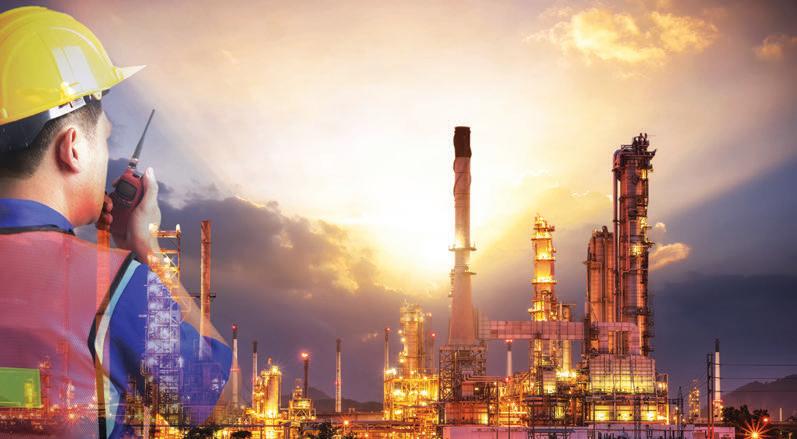

In the NETR, Malaysia has committed to revising its RE capacity target to 70% by 2050, up from the previous target of 40% by 2035, as part of its energy mix. This poses an important question: With the oil and gas industry currently contributing about 70% to the energy mix, how will this transition impact the industry?
The fossil fuel industry in Malaysia has been a significant driver of economic growth but has also contributed to carbon emissions. Therefore, there is a pressing need to accelerate emissions reduction and pursue a just energy transition. A just energy transition aims to green the economy in a fair and inclusive manner, creating job opportunities and leaving no one behind, as stated in the National Energy Transition Roadmap – Part 1 by the Ministry of Economy in August 2023.
As a developing nation, Malaysia advocates for a just transition to ensure no one feels left behind or is powerless in terms of energy security and economic disparity. We remain committed to the goal of achieving net-zero emissions and the NETR provides essential guidance and policy changes for our economy. It’s important to note that addressing climate change is not the sole responsibility of the oil and gas industry, even though it’s under scrutiny.
According to NETR, Malaysia faces the critical task of transitioning from a conventional fossil fuel-heavy economy to a high-value green economy while aspiring to achieve net-zero greenhouse gas emissions by 2050. It is imperative for the O&G industry to integrate ESG practices into its business operations for survival. Companies like Hibiscus Petroleum, PETRONAS-listed entities and other O&G companies listed on BURSA Malaysia have been incorporating ESG practices and reporting their ESG performance in annual reports to comply with BURSA requirements.
Many companies have taken measures to reduce flaring, identify fugitive emissions sources, adopt energy-efficient equipment and
digitalise operations to optimise efficiency and reduce emissions. Engineers are actively contributing to emissions reduction efforts in their daily work, as emissions and energy usage are closely monitored and reported. Therefore, engineers have a unique advantage in adding value to other industries by improving energy efficiency and waste management, aligning with broader ESG goals.
PETRONAS outlined its carbon capture and storage (CCS) project, Kasawari, in its 2022 Integrated Report and PETRONAS Activity Outlook 2023-2025. In NETR, CCS is identified as one of the key flagship catalyst projects and initiatives. With their expertise in geotechnical and reservoir management, O&G players can lead CCS development in the country. While there is a growing shift towards renewable energy sources like solar, wind, biofuels and hydrogen, fossil fuel products still have applications across various industries, including chemicals, manufacturing and construction. CCS projects are pivotal in our journey toward a net-zero emissions goal.
On the social and governance fronts, the O&G industry can share best practices in safety management and governance policies, especially concerning local participation. Safety is of paramount concern due to the hazardous nature of hydrocarbons. The industry has demonstrated its ability to manage worker safety and health effectively during construction activities, turnarounds and plant commissioning, aligning with international standards for social and governance performance. These experiences can be shared with other industries to elevate ESG efforts in Malaysia.
To adapt to external pressures and to ensure business sustainability, the industry has been exploring non-

Ir. Lee Chang Quan
The Chair of OGMTD, IEM (2022/2023) is also serving Stand Comm. of InfoPub. He has experience in engineering and project management of petrochemical plants projects.
fossil fuel opportunities, including renewables such as solar, wind, biofuels and hydrogen. PETRONAS, for instance, has initiated a feasibility study for a biorefinery to produce sustainable aviation fuel (SAF) as part of its decarbonisation efforts.
Collaboration among industry leaders and research institutions will accelerate the transition to a greener path while balancing cash flow with investments in new technology. Engineers and researchers will play a crucial role in driving the growth of biofuels in Malaysia, aligning with NETR’s flagship catalysts such as biomass demand creation and future fuels.
IEM can play a significant role by integrating the 17 UN SDG goals into its activities, raising awareness among engineers about ESG and influencing businesses to incorporate ESG practices. OGMTD can also engage in outreach programmes aimed at engineering students to dispel concerns about future careers in the O&G industry and to emphasise the demand for engineering talents in achieving the transition to a green economy. Indeed, NETR’s success hinges on active and immediate participation by engineers in shaping the country’s future.
[1] PETRONAS, 2023. Available from https://www.petronas.com/media/media-releases/petronasreleases-2023-2025-industry-activity-outlook
[2] PETRONAS, 2022. Available from https://www.petronas.com/media/media-releases/petronaseni-and-euglena-explore-biorefinery-opportunity-malaysia

















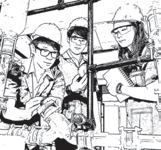





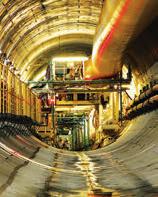





































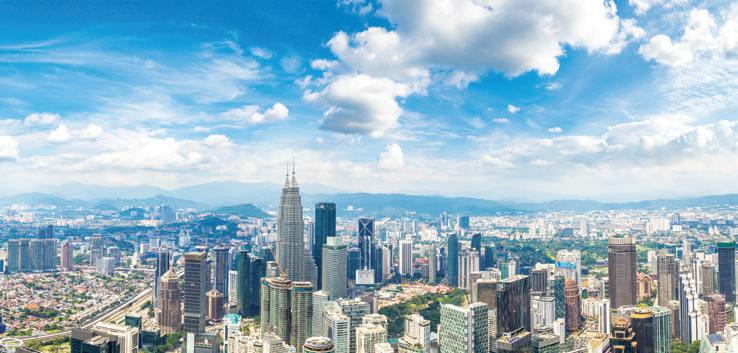
Written and Prepared by:

Tajul Ariffin bin Mohamed Nori Chairman of Safety in Engineering Special Interest Group, SESIG IEM and a senior officer with Forensic Engineering Division at DOSH Headquarters Putrajaya.
Major hazard accidents can arise from factors such as human error and other contributing factors, including design or construction errors, operational mistakes, technical failures, hazardous spills, fires, explosions, dam failures, structure collapses, inadequate maintenance or supervision issues.
However, another factor that can trigger major hazard accidents is Natech or Natural Disaster-Induced Technological Accident. This refers to a situation where a natural disaster triggers a technological failure, leading to serious environmental and social consequences. Such accidents can damage infrastructure, cause loss of life and/ or have significant economic impacts. Even though the risk is not new, Natech must be addressed.
As technology advances and industrial growth accelerates, so does climate change (which causes natural hazards) keep changing in time and location. Thus it is essential to review this to avoid any catastrophic event from natural risks triggering technology disasters. Earthquakes, floods and storms significantly affect large areas in single or continuous occurrences, posing a major threat to any major hazards plant or industrial zone. The domino effect can propagate from natural events and affect any man-made plant auxiliary systems and utilities, causing worst-scene situations for emergency response and rescue.
Safety engineering protection barriers in place such as warnings or alarm systems, instrumentations or failedsafe-system, may not be able to deal with natural disasters
to prevent major technology incidents. Thus it is crucial to manage the Natech risk.
Managing the risk of natural disasters or Natech can be challenging. The risk assessment process stage may identify those who will be impacted by the threat of specific hazards. For instance, in the case of Natech risk, the population as a whole, especially those staying in close proximity to the hazardous area, may experience harm rather than just individuals or specific groups of people employed within the working perimeter of the Major Hazard Installation plant. Effective risk management involves continuous communication and consultation with both internal and external stakeholders. It is important to acknowledge that stakeholders may perceive risks differently due to variations in values, interests, needs, assumptions, concepts and concerns.
In order to ensure safety for all, laws and provisions have been established to encompass major hazard undertakings. The Occupational Safety & Health Act, Control of Industrial Major Hazard (CIMAH) Regulations 1996 [1] mandates plant owners to engage with stakeholders, including the public. Even though the provision is in place to protect the public via engagement with nearby residents, it is still minimal to protect the public from being affected by Natech risk. Furthermore, due to limited awareness of Natech risks, the public often relies on industrial operators or plant owners to ensure their safety without considering their emergency preparedness.




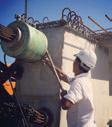
- Post-tensioning solution provider
- Carpark Flat Slab
- Transfer Plate
- Beams, Box Girders
- Alternative design solutions
- Cable systems (stay cable main cable hanger)
- Bridge bearing and expansion joint
- Construction solutions (heavy lifting, ILM, etc)
- Monitoring, repairing and strengthening for structures




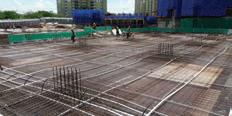
Prestress Sdn Bhd (1140945-A)
The Strand, Kota Damansara 47810 Petaling Jaya
Selangor Darul Ehsan
Tel : 603 6142 6638
Fax : 603 6142 6693

Email : enquiry-pt@nehemiah-grp.com


Risk management is essential for preventing such accidents. It involves identifying hazards, assessing their risks, developing strategies to mitigate them and regularly reviewing and updating these strategies. Prevention measures include hazard-resistant design, early warning systems, emergency response plans and regular maintenance of technological systems. By effectively managing risks and implementing preventive measures, the impact of Natech accidents can be minimised, ensuring the safety of individuals and communities.

Climate change poses great potential risk for natural induced event to major hazard industry (Royalty-free image from pixabay.com)
The potential consequences and unforeseen incidents of technological accidents can arise due to climate change impact. When developing resilience to prevent technical and industrial catastrophes triggered by natural disasters, it is crucial to incorporate the impacts of natural phenomena into the risk assessment process. For example, engineers and designers should consider the effects of calamities during the disaster risk reduction design phase to create structures which can effectively withstand such events. However, the inputs guiding the design decisions risk assessment can significantly influence the design of industrial plants or structures. Reliable and valid data, such as meteorological department data, is crucial for accurate risk assessments. It enhances precision and reliability, providing valuable insights of weather patterns, climatic conditions and natural hazards. This data makes risk assessments more comprehensive, enabling informed decision-making and effective mitigation measures. Reliable data sources contribute to a better understanding of risks and so will support successful risk management strategies. Consequently, incorporating climate change considerations into sustainable design against Natech accidents can be challenging and will require careful decision-making for optimal outcomes. A technical report published in 2022 by the Joint Research Centre (JRC), the European Commission, Natech Risk Management – Guidance for Operators of Hazardous Industrial Sites and National Authorities [2] would serve as a comprehensive guide in managing Natech risk.
Another important strategy in managing Natech risk is preparedness. By implementing effective emergency response measures, the severity of consequences in natural disasters can be significantly reduced, leading
to fewer casualties. It’s important to note that Natech accidents have the potential to affect not only industrial facilities but also adjacent areas, as indicated in the Bhopal accident, where residential areas located 2-3km away from the disaster site were impacted [3]. An occurrence of a Natech accident could lead to cascading scenarios similar to major hazard accidents within industrial or chemical parks.
In Malaysia, plants classified as “Major Hazard Installations” are required to comply with CIMAH Regulations 1996. Plant owners have a legal obligation to protect the off-site society from the adverse effects of their operations. The regulation emphasises the importance of raising public awareness by providing necessary and adequate information about technological disasters. Technological advancements such as social media tools can enhance the implementation of these requirements by facilitating the effective dissemination of frequent and timely information. Additionally, engagement programmes can be organised to ensure the public possesses sufficient knowledge to protect themselves during a Natech accident.
Since Malaysia experiences two distinct tropical seasons, namely the monsoon and dry seasons, lightning strikes are common. This random phenomenon can potentially erupt at any hazardous plant to trigger a major hazard incident. For example, a major fire outbreak which occurred at a crude storage tank of a local refinery in Port Dickson, Negeri Sembilan, in 2020, was believed to be triggered by a lightning strike. Fortunately, most hazardous material (hazmat) facilities and major installation sites are equipped with lightning arrestors. The fire was successfully contained, preventing it from affecting the crude oil content which could have worsened the impact. This case study highlights the importance of managing Natech risks through proactive measures such as installing fire prevention and mitigation systems in chemical storage facilities.
In 2020, a massive major hazard in Beirut, Lebanon, sparked global concern over how such an incident could have happened. The catastrophic port explosion caused a huge number of deaths and injuries and over US$15 billion in property damage, resulting in a great economic loss. This event underscored the critical importance of effective risk management and raised awareness of the devastating consequences that could arise from a major hazard. This is a reminder for seaports, jetties or other facilities in Malaysia which store, process or engage in trading activities involving various hazardous bulk materials. Such facilities can cause major hazard incidents that can jeopardise public safety, especially during natural disasters which may trigger such events.
In Malaysia, many plants, such as oil refineries, petrochemical plants and electric power plants, which fall under the major hazard category under CIMAH Regulations 1996, are located along the coastline. Since coastal areas can be affected by hurricanes and tsunamis, engineers and

designers should consider these natural disaster hazards in their risk assessment and design the safety factor appropriately. The natural disaster impact should not be undermined although some of the hazards are perceived to be uncommon in Malaysia. The 2004 Indian Ocean earthquake and tsunami for example, affected Malaysia and caused significant damage to the north coast[4].
A safety report is an essential tool for CIMAH-competent persons to effectively manage, prevent, control and mitigate major hazard accidents within major hazard plants. However, it is crucial to emphasise Natech risk in the safety report prepared by CIMAH competent persons. The report should outline specific measures and strategies to address Natech risk, such as incorporating resilient design and engineering practices, developing emergency response plans that account for natural hazards and establishing communication protocols with relevant authorities and neighbouring communities.
Moreover, the safety report should provide clear guidelines and procedures for monitoring, reviewing and updating the management of Natech risk over time. This includes periodic assessments of the effectiveness of existing control measures, the identification of emerging risks and the implementation of necessary control measures and improvements. By integrating Natech risk into the safety report, CIMAH competent persons can ensure a holistic and proactive approach to managing major hazard accidents. This facilitates better preparedness, response and resilience against the potential impacts of natural hazards on industrial facilities, surrounding communities and the environment.
In addition to the CIMAH Regulations 1996, the Department of Occupational Safety & Health (DOSH) had also published the Guidance on Preparation & Updating of Report on Industrial Activity, to assist industries, specifically CIMAH-competent persons, in preparing safety reports. It outlined some essential information which could be related to Natech risk, as outlined in part D, Schedule 6 (d): Information relating to the Potential Major Accidents - D.1 “A description of the potential sources of
major accidents and conditions or events which could be significant in giving rise to one and D.4 - Information about the prevailing meteorological conditions in the vicinity of the site)” on the possibility of external factors such as earthquakes. Even though earthquakes [5] are not a typical occurrence, Malaysia remains vulnerable to various other environmental disasters, including flood, landslide and tsunami [6]. While the growth and expansion of industry are getting more developed, climate change may bring unexpected natural disasters. This should be a part of the continuous hazard study for CIMAH-competent persons, especially for plants in areas where it prompts natural risk.
Natech accidents pose significant risks to the environment and human lives, necessitating the implementation of robust risk management and prevention strategies. These measures are crucial in mitigating the potential consequences of natural hazards on technological systems and ensuring the well-being of both our ecosystems and society. By identifying Natech hazards, assessing risk, developing strategies and regularly reviewing and updating these strategies, it is possible to manage the risk of Natech accidents more effectively. The CIMAH Safety Report plays an important role in managing Natech risk and must include considerations for Natech risk management.
[1] Occupational Safety and Health Regulations, (Control of Industrial Major Hazard) 1996
[2] DOSH Guidance on Preparation and Updating of Report on Industrial Activity
[3] Bowonder. B (1992) Learning from the Bhopal accident. Contemporary South Asia 1:2, pages 281-289. https://doi.org/10.108 0/02688867.1987.9726622
[4] Keizrul Abdullah, Tan K.S. and Ghazali N.H.M. (2005) No More in the Comfort Zone – Malaysia’s, Response to the December 2004 Tsunami. International Hydrography and Oceanography Conference, Kuala Lumpur, July 2005
[5] Shaluf, Ibrahim Mohamed, and Ahmadun, F.-R. (2006). Disaster Types in Malaysia: An Overview. Disaster Prevention and Management, 15(2), 286–298. Https://Doi.Org/10.1108/09653560610659838
[6] AHA Centre - ASEAN Coordinating Centre for Humanitarian Assistance. (2019). https://ahacentre.org/
[7] Cruz, Ana Maria, and Okada, N. (2008). Methodology for Preliminary Assessment of Natech Risk in Urban Areas. Natural Hazards. Https:// Doi.Org/10.1007/S11069-007-9207-1
[8] Steinberg LJ (2004) Natechs in the United States: Experience, Safeguards, and Gaps. In: Vetere-Arellano AL, Cruz AM, Nordvik JP, and Pisano F (eds) Proceedings: NEDIES Workshop Analysis of Natech (Natural Hazard Triggering Technological Disaster) Disaster Management. Report EUR 21054 EN, DG Joint Research Centre, European Commission, Ispra, Italy
[9] Steinberg LJ, Cruz AM (2004). When Natural and Technological Disasters Collide: Lessons From the Turkey Earthquake of August 17, 1999. Nat Hazards Rev 5(3):121–130
[10] Joint Research Centre (JRC). The European Commission, Natech Risk Management - Guidance for Operators of Hazardous Industrial Sites and National Authorities, 2022.
[11] Occupational Safety and Health Act 1994
FOR ELECTION TO FILL VACANCIES FOR THE COUNCIL SESSION 2024/2025
The IEM Council at its 437th meeting on 17 July 2023 had decided to fill Council vacancies for the Session 2024/2025 in accordance with Article 5.2 of the Constitution. An election programme had also been approved by the Council for implementation.
The following Council vacancies will arise for Session 2024/2025 as a result of Council members retiring at the end of Session 2023/2024.
Office No of Vacancies
Vice President Three (3) 2 sessions (2024/2025 and 2025/2026)
Honorary Secretary One (1) 1 session (2024/2025)
Honorary Treasurer One (1) 1 session (2024/2025)
Council Member
– Chemical & Other Representative One (1) 3 sessions (2024/2025, 2025/2026 and 2026/2027)
Council Member
– Ordinary Representative Ten (10) 3 sessions (2024/2025, 2025/2026 and 2026/2027)
A notice inviting nominations for the Election of Council Member for Session 2024/2025 will be posted on the IEM Notice Board and on the website on 10 November 2023 for the information of all Corporate Members.
Nomination Forms may be obtained at the IEM Secretariat or downloaded from the IEM website www. myiem.org.my on and after 10 November 2023.
All Nomination forms, duly completed, shall be sent in a sealed envelope marked “Confidential: Nomination Paper for Session 2024/2025” to:
The Institution of Engineers, Malaysia BangunanIngenieur, Lots 60/62, Jalan 52/4 P.O. Box 223 (Jalan Sultan) 46720 Petaling Jaya, Selangor DarulEhsan Tel: 03-79684001/2
and to reach her not later than 12.00 noon on Saturday, 9 December 2023.
Dato’ Paduka Ir. Hj. Keizrul bin Abdullah Election Officer 2023/2024
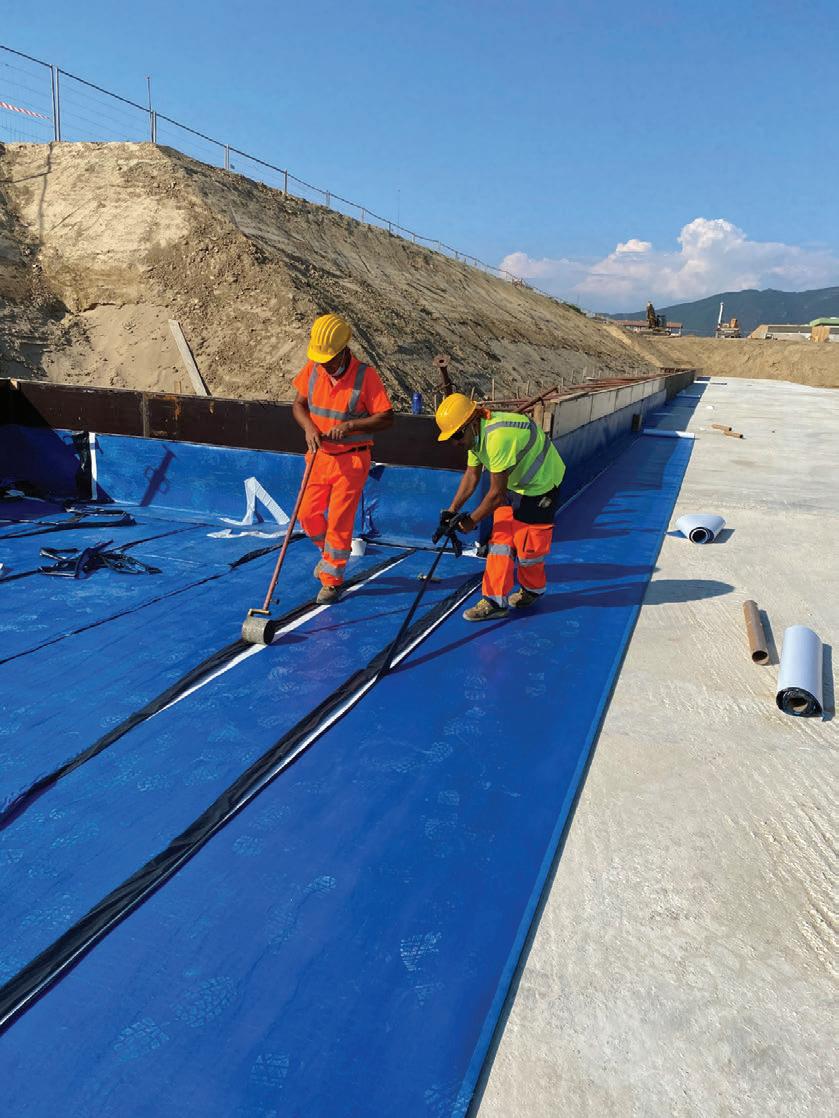
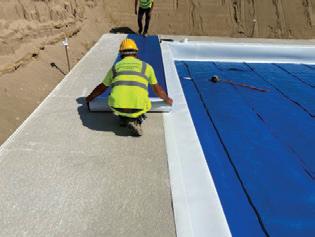



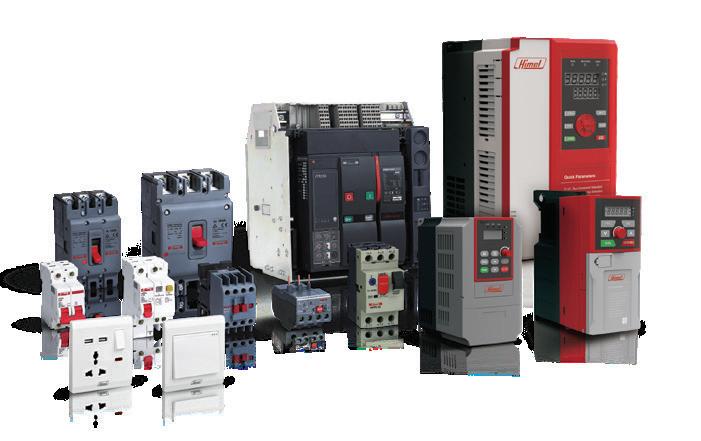

Written and Prepared by:

Ir. Hj Look Keman bin Sahari
A Committee Member of OGMTD, he is Consultant Engineer specialising in Explosive Engineering & Blasting Engineering and Expert Witness in Blasting dispute.
When hard rock is encountered during excavation work, it can be removed either mechanically or by using explosives. However, fear of causing accidental damage to property, risk of human injury, limited expert knowledge of proper blasting techniques as well as difficulty in securing the necessary permits for blasting have resulted in more and more contractors opting for mechanical rock excavation methods instead. In most cases, however, mechanical excavation is slower and may end up being more costly than if controlled blasting is employed.
This article discusses the concerns and factors that affect the implementation of controlled blasting and offers a practical approach for developing a controlled blasting programme. Common public perception of the dangers of blasting and the necessity for carrying out risk analysis and management are also explored.
To blast or not to blast? This is a common question that engineers and contractors often ask themselves when faced with the need to remove hard rock within an urban setting. Increasingly, the tendency is to opt for mechanical excavation or even the use of chemical means rather than to drill and blast although the former options are usually more costly.
Why is this so? Often, in urban construction work, there is immense pressure from government agencies to avoid blasting as far as possible because blasting creates a huge public relations problem for project owners as well as their design consultants. The overall public perception of the safety of blasting has largely been shaped by negative outcomes of events in Iraq, Syria or Palestine as well as explosions in Kenya, Oklahoma and many other locations worldwide that have claimed the lives of many civilians. These events have created great fear among the general public on the extensive damage that can arise from the use of explosives especially when such devices are to be deployed at a site close to their homes. As a result, this public uneasiness has had a significant influence on the choice of the preferred excavation method in cases of populated areas.

According to a recent newspaper report, a municipal council in Selangor had rejected an application by a contractor to undertake blasting work at a construction site when nearby residents expressed fear that the blasting would endanger their lives. In addition to the resulting tremendous and unbearable noise disturbances, the residents were also worried that the blasts might create flyrock or ground vibrations that could damage their homes.
These public objections might leave the contractor with little choice but to adopt mechanical and/or chemical means to remove rock, such as by using breakers to break up granite outcrops or boulders and chemicals to fragmentise the rocks. However, the residents would now be subjected to lengthy periods of continuous rock hammering caused by the breakers rather than just a few weeks of minimal disturbance if the blasting was carried out professionally.
The overall cost of mechanically breaking the rock would be enormous while the nearby residents would have to tolerate the noise, dust and other disturbances longer than was necessary. Another result of this “no blasting” rule was that the high cost of rock removal would ultimately be passed down to the prospective home buyers and property investors who would eventually have to pay higher prices.
While litigation for alleged blasting damage is common, particularly in the United States, this is not yet the case in Malaysia. While contractors here have been threatened with lawsuits by certain quarters, many have not materialised due to the lack of technical knowledge on the associated risks and effects of blasting on various structures, as well
as failure on the part of the litigant to prove that he has, in fact, suffered a loss as a result, especially if the blasting contractor is backed by a competent consultant with expert knowledge in this field.
Many house owners assume that any blasting work is likely to cause damage to their existing properties, regardless of whether the resulting vibrations are below or beyond the maximum limit imposed by the authorities, which is usually 10 mm/s. This limit is actually well below the threshold limit of possible cosmetic damage of 50 mm/s, as recommended by the United States Bureau of Mines (USBM). Regardless of the validity of the claims, these can be very costly for a contractor to defend as he will need to hire one or more experts to investigate the claims, as well as a lawyer to defend him in court. Additionally, the threat of a “stop work” order can mean a complete halt to the work while the complaint or allegation is being investigated by the authorities. Since the cost of defensive action can be astronomical, the blasting contractors must plan their work extremely carefully to ensure that it is in compliance with the relevant codes and regulations. The blasting process must be carefully selected, controlled and monitored to prevent property damage which can lead to complaints and possible litigation.
Blasting Perception vs Reality
People are primarily concerned about blasting in urban areas because they believe it is dangerous or that it commonly causes property damage. When blasting accidents do occur, they are highly publicised by the media, while the numerous success stories go unreported. As a result, the local populace has developed a negative view of rock blasting. Unfortunately, many blasting accidents are caused by human error or by a lack of expert knowledge on the part of the contractor. These include making the wrong decisions, incorrect blast design, selecting an unsuitable loading arrangement and adopting improper control measures for a specific site or situation. The implementation of inconsistent or differing regulatory requirements by the authorities may also be a contributory factor.
Human error may be reduced significantly by tightening the training and experience requirement for licenced blasters. Currently, there are no institutions in Malaysia offering specialised training on blasting techniques in urban and other sensitive areas nor is there a requirement for a blaster to attend such a course. The Institute of Quarrying, Malaysia, and the Malaysian Police conduct shot-firing courses but these are tailored more for quarry work than for civil engineering infrastructure work. Due to security reasons, only those with the need to know this field of work are allowed to attend such courses.
Blasters are only required to possess a Shot-firer’s Certificate which is issued jointly by the Police and the Department of Minerals & Geoscience. However, this certificate is more relevant to those who work in quarries where the applicable blasting techniques and the resulting risks are quite different. The blasters and engineers,
unfortunately, are only able to learn from practice through trial and error or by reading and self-study of technical literature if they are fortunate to be members of learned societies such as the International Society of Explosive Engineers. It is very difficult for the blasting engineer to acquire appropriate experience in blasting at close quarters, since there is no requirement for a blasting contractor to hire one.
Generally, blasting contractors are reluctant to hire competent professional engineers to oversee their blasting work on the pretext that their blasters do not need to be supervised. Moreover, it is claimed that in many instances the engineers themselves rely on the blaster to make key decisions. In fact, many blasting contractors will argue that the hiring of engineers adds little value and only increases their operational costs.
There is therefore a clear need for the specialised training of blasting engineers to improve their competency levels and to prove their worth. Unfortunately, there is a lack of interest from engineers to specialise in blasting work as the tasks are seen to be difficult and dirty and requires one to be continually exposed to the hot sun.
There is also a parallel need for the proper training for blasters working outside of the quarrying and mining industries as the specific requirements related to controlled blasting practice will improve their levels of expertise and lead to fewer accidents or adverse events. This will also increase the confidence of the public and reduce unnecessary anxiety.
Before a project owner considers a proposal to incorporate blasting as an appropriate engineering solution, he or she must consider several pertinent factors. Blasting work in an urban or sensitive area is definitely much more costly than blasting work in a quarry or mine. The blasting engineer has to consider the higher risk of accidents and thus needs to implement stringent precautionary controls to ensure that nearby properties are safe and protected. The estimated volume removed per blast has to be kept at a very low level, measured in hundreds of cubic metres per blast compared to several tens of thousands of cubic metres at a quarry.
Quite often, civil engineering consultants have been found to unknowingly borrow specifications meant for blasting at quarries (or other blasting sites) and inappropriately apply them for blasting work in an urban or sensitive environment. There had been instances when the initiation method specified, such as the safety fuse or the detonating cord, was incorrect for a particular location or where the stipulated electrical system had been chosen to save cost rather than to ensure greater safety.
In another example, the specified explosive was not even available in the country, suggesting that the specifications had been reproduced from a foreign source.
At present there is no blasting standard for vibration and air-blast control in our country. Different consultants tend to adopt standards from developed countries such as
Australia, the United Kingdom and USA. Some consultants prefer to choose the lowest possible limit to ensure approval by the authorities only to discover later that the limit is unsuitable for the specific location and is very expensive to comply with. While the Australian Standard limits of 10 mm/s for vibration and 120 dB(L) for air-blast are applicable in most cases, there may, however, be circumstances where a lower or even higher limit may be more appropriate. It is therefore, essential that the specifications proposed for implementation be appropriate and practical for the particular location to avoid the problem of non-compliance which can lead to cost overruns and the need to appeal to the relevant authority for modification of the original specification.
It is quite common practice in Malaysia for a consultant to be hired to prepare the blasting specifications when the approving authority requires a written Method Statement to be submitted for review but to save costs, he is not appointed by the project owner or blasting contractor to oversee and supervise the job after that.
One very important requirement in any blasting specification is the need for the blasting work to be recorded correctly. The blast design must be clearly indicated, with details of burden, spacing, depth, blasting location, type of explosive used as well as the protection methods to control fly-rock properly recorded with reference to an accompanying site plan. Videos or photographs of the blasting work must be taken throughout the entire procedure until completion. Vibration and air-blast monitoring plans must be implemented and recorded correctly to check and confirm compliance. This is actually a necessity to protect the owner from possible complaints from the public, which can result in claims for compensation and litigation in court. The records also serve as supporting documents during routine inspections and discussions with the authorities.
Finally, the most important element in the carrying out of controlled blasting is public relations. The blaster, the project manager, the owner and the engineer must develop and maintain good relationships with the surrounding community and keep them informed of ensuing developments. If all parties show genuine concern and respect for the safety and well-being of those affected by the blasting work, they will in turn ensure that the operation proceeds smoothly. “Make them feel safe and you will feel safe.”
Blasting work is actually very safe when performed by competent and qualified personnel. It is also much cheaper on sites where extensive hard rock is encountered compared to rock breaking by mechanical or chemical means and is much faster too. However, the blasters and the engineers involved in this field must be willing to improve their technical skills and competency as well as prove that they are able to perform the required tasks safely while causing minimal disturbance to the public.
They must also be knowledgeable of the effects and the inherent risks of blasting work on nearby structures and understand the psychological impacts of blasting on the affected community. It should be noted that most blasting works have been completed safely and successfully in the past and will be so in the future. It can be very satisfying when the job is well done and appreciated.
[1] To blast or not to blast – Journal of Explosive Engineering, July/ August 1996
[2] The Consultant’s Perspective - Forcon International, Autumn 2002

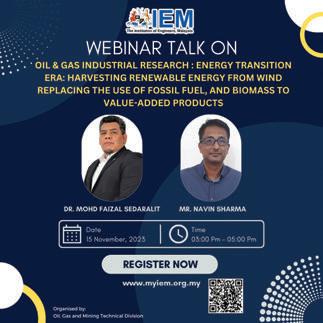

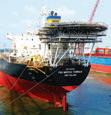
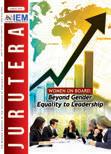

















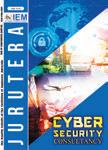
Written and Prepared by:

Founding Principal Engineer of East 101 Sdn. Bhd., a specialist process engineering and flow assurance consultancy. He has 30 years of experience in dynamic/ transient analyses for design and operations.

In this analysis, a fuel gas import system on a Floating Processing Storage & Offloading facility is subjected to a cold blowdown or depressuring analysis using the HYSYS process simulation software. As part of the system shut down procedure, it is necessary to depressurise the system from its operating pressure of around 150 barg down to 6.9 barg. When the system is depressured, the fluid and corresponding piping and equipment wall temperatures will drop due to expansion and the Joule Thompson effect.
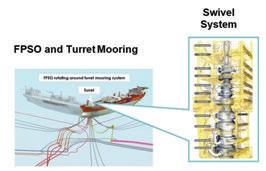

Ph.D. student at King Abdullah University of Science and Technology in Jeddah, KSA. His current research focuses on the thermodynamics and interfacial properties of brine/hydrocarbon/gas mixtures.
The objective of a cold blowdown analysis is to determine the minimum metal temperature for the piping and equipment within the system. In cases of design, this temperature would be used as the minimum metal design temperature. For existing systems, this analysis would be used to determine if a blowdown strategy would result in the system temperature approaching or breaching the minimum design metal temperature. A common approach used in performing a cold blowdown analysis in using commercial simulation software like HYSYS, is the lumped model strategy where the whole system, piping and equipment is represented using a single vessel. The minimum metal temperature determined by this simulation is considered the minimum temperature for this system.

Prior to conducting a distributed cold blowdown analysis, the client had conducted a traditional lumped cold blowdown using the HYSYS simulation software. This analysis indicated that the minimum observed fluid temperature was -41°C and the minimum inner wall temperature was -23°C.
The problem in this case was the inlet swivel piping and equipment design temperature was -30°C whereas the inlet heater, metering and downstream piping design temperature was -60°C.
The lumped model had insufficient granularity to determine:
• The location of cold spots and accurate inner wall temperatures.
• Where temperatures may be lower than the “average/ lumped” predicted temperature. Could the minimum metal temperature be lower than -23°C? The default model did not consider forced convective heat transfer effects.
• If every point in the system was at a safe margin above minimum design temperature. There was concern that the low temperatures predicted by the lumped model may occur at the swivel section, which had a design section of -30°C.
The solution to this was to perform a transient analysis based on a distributed model approach to:
• Account for individual equipment/piping inventory, pressure drop and heat transfer
• Create a finite element-based rigorous wall model for better thermal and temperature gradient prediction across the wall.
The software environment at that time, Aspen HYSYS version 7.3, lacked the necessary features to enable this rigorous analysis, so it was necessary to develop custom inhouse heat transfer tools to account for the fluid side heat transfer, conduction, free and forced convection as well as a Finite Element Method for the wall conduction.
The distributed blowdown indicated that the coldest fluid temperature of -40°C occurred at the heat exchanger and that the minimum observed inner wall temperature was close to -30°C.

However, these temperatures occurred where the material design temperatures were -60°C. So there should be no risk of material embrittlement. The QR code below links to an animation of the blowdown and its effect of the axial temperature profile from the gas riser to the outlet of the fuel gas metering system.




In addition to this, the Finite Element Analysis computation indicated that the minimum wall temperature at the swivel was around -9.5°C, far above the design temperature of -30°C. The QR code below links to an animation of the blowdown and its effect of the temperature profile across the thinnest swivel wall section.

Conclusion
Implementing this distributed cold blowdown and finite element method heat transfer analysis allowed for the determination of the detailed spatial temperature distribution in this system.

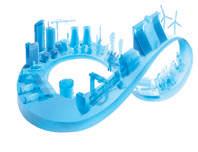

This study was conducted for an upstream FPSO. However, the methodology is applicable for any high-pressure system in a refinery or downstream facility, hydrogen and gas recovery or storage systems and reactor units.
This detailed analysis enables:
CapEx Reduction: By accurately identifying potential embrittlement areas, eliminating unnecessary usage of expensive low-temperature construction materials.



Enhanced Safety & Reliability: By getting high resolution visibility on temperatures across the system and thus ensuring piping and equipment metal temperatures remain above the minimum design metal temperatures, avoiding potential embrittlement failure during blowdown.






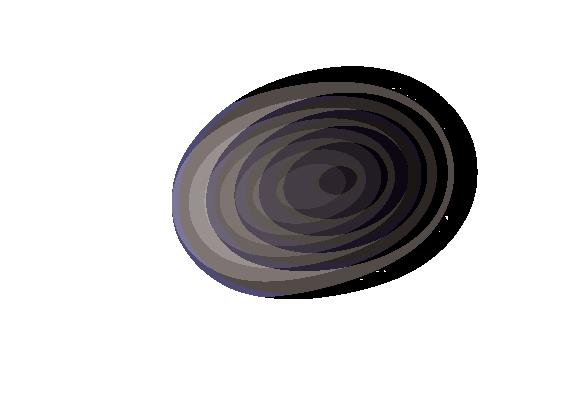







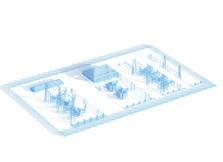

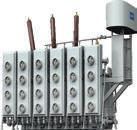














The Golden Bridge in Ba Na Hills resort is the most attractive tourist spot in Danang, central Vietnam. It is a unique and stunning architectural wonder that is a must-see for any traveller visiting that part of the country.
This yellow-hued pedestrian bridge appears to be supported by two gigantic hands symbolizing the hands of God carrying the gift from the ground, it is 1414 meters above mean sea level.
The Golden Bridge is 150 metres long and has 8 spans and 7 supports, designed to connect Marseille cable car station and Le Jardin d’Amour Garden. Most spectacular are two supports made in the form of five-finger “stone” hands

Written and Prepared by:

Committee Member of Standing Committee on Information & Publications
constructed of fibreglass and wire mesh, giving the visual effect of the entire bridge being held by that two hands.
The Golden railings of the bridge are made of stainless steel and the flooring is made of dense and high-quality wood that can withstand heavy loads.
Construction of the bridge began in July 2017 and was completed in April 2018. The bridge opened in June 2018 and since then it became the tourist icon of Danang. Standing on this bridge offers visitors breathtaking panoramic views of the surrounding mountains, forests and rivers.
At the end of the bridge, there are some stone statues of gigantic hand and legs, equally interesting. I enjoyed the visit of this tourist spot very much on August 19, 2023.
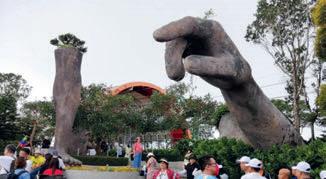







Written and Prepared by:

The 11th episode of Sembang Chillex, an initiative by the Institution of Engineers, Malaysia (IEM), was held on 9 September, 2023, at the Kuala Lumpur Convention Centre, to coincide with the Engineer & Marvex conference. The event, moderated by Ir. Dr Nor Ilia Anisa binti Aris and Ir. Ts. Dr Denesh a/l Sooriamoorthy, centred around discussions on sustainability in the engineering profession.
The panellists were engaged in a lively discussion on the shared mission of elevating IEM as a pivotal platform for fostering science and technology in the field of engineering, particularly among young enthusiasts. We extend our heartfelt appreciation to our panellists: Ir. Abdul Razak bin Yakob (Chairman, Towards a Responsible Future Task Force, IEM), Ir. Dr Siow Chun Lim (Senior Lecturer at the Faculty of Engineering, Multimedia University) and Ir. Assoc. Prof. EUR. ING. Ts. Dr Syuhaida binti Ismail (Director of Research, Maritime Institute of Malaysia, Kuala Lumpur).
There were discussions concerning IEM’s mission and vision for sustainable engineering. The conversation encompassed opportunities and challenges that IEM faced in its quest to promote sustainability within the engineering realm. Moreover, the dialogue touched on activities carried out in universities to instill a sense of sustainability among

students. The panellists also offered insights into IEM’s engagement with the government and policymakers to influence policies and regulations, with a strong emphasis on IEM’s support for the transition to a circular economy in local engineering projects. Finally, each panel member shared valuable advice on how engineers could actively contribute to sustainability.
The question-and-answer session featured active participation from the audience, with six questions and suggestions received from various individuals, including Ms. Dalili Fahimah binti Zaid, a student from USIM, Ms. Nur Afiyah Amira binti Mohd Shahiman, a member of the IEM student committee from UiTM, Ir. Thayala Rajah a/l C. Selvaduray, the IEM Southern Branch Chairman for 2023/2024, Tc. Harrieez bin Iskandar (UTM, Space KL) and Ir. Dr Siti Hawa binti Hamzah. To conclude the event, tokens of appreciation were also presented to the audience members who actively participated in the question-and-answer session, as well as to all the panellists.
The Sembang Chillex event was marked by excitement, emotional resonance and active engagement among both panellists and the audience. One could sense their collective hope for a more sustainable Malaysia and the critical importance of supporting IEM in this noble endeavour.

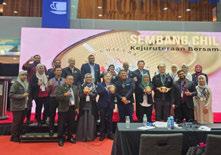
Written and Prepared by:


Diversity plays a crucial role in scientific excellence and advancement. Recognising the importance of promoting diversity in education, IEM Women Engineers Section (WE) has been playing a role in supporting Women in Zcience (WiZ) each year. This signature programme, organised by Tech Dome Penang, in collaboration with the Penang Women’s Development Corporation (PWDC), is aimed at fostering scientific learning among children and building a strong foundation of continuous learning for their future.
This year, the programme was launched on 28 March 2023 with workshops and competitions in science, technology, engineering and mathematics (STEM). Some 250 students from six schools benefitted from this programme.
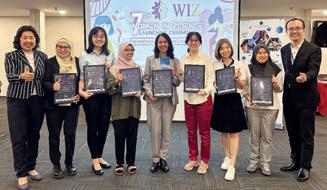
During the launch of WiZ, IEM WE representative Ir. Mah Siew Kien delivered a talk titled From Classroom to Career, which emphasised the importance of STEM subjects. She gave inspiring advice and reminders to participants to stay steadfast as they diligently pursue their dreams in the engineering profession.
Next, a speaker from Intel, Dr Beth Yam, delivered an interesting talk titled Inspiring Women Engineers. She shared the contributions of women in the engineering industry as well as the breaking stereotypes surrounding gender roles within the STEM field. To enhance the learning experience, there was also a panel sharing session comprising women

engineers from top semiconductor companies such as Intel, Flex, Plexus and Jabil. The session provided opportunities for participants to interact face to face with the panellists. This way, they would gain invaluable advice on embracing diversity at workplace and overcoming challenges which would lead to successful careers in engineering.

One of the highlights of the WiZ programme was the drone workshop and challenge on 13 May 2023 at Tech Dome, Penang. The workshop was conducted by 3 IEM representatives – Ir. Mah, Ms. Pooi Ying and Ms. Jacquelyne – and students from First City University College, headed by lecturer Ms. Shuhada from the Faculty of Engineering and Computing as well as representatives from Tech Dome.
At this workshop, students were exposed to drone technology including the essential 21st century developmental skills such as coding, problem-solving and teamwork.
During the workshop, the students were given an hourlong tutorial on drone coding and control. This introductory session familiarised them with the basic principles of drone manoeuvrings and laid the foundation for the practical segment of the workshop. Subsequently, the participants were allocated another hour to apply the coding skills to control the drones for executing set tasks. The workshop not only exposed the students to cutting-edge drone technology but also demonstrated that STEM was
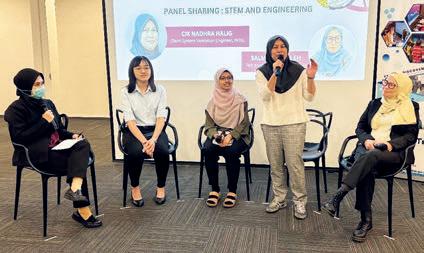

interesting, thus encouraging them to embrace STEM subjects and to pursue careers in engineering and its related fields. The hands-on experience with drones and coding were aimed at igniting curiosity, nurturing problem-solving abilities and inspiring passion for scientific explorations.
To conclude the workshop, a thrilling drone challenge was organised where participants had the opportunity to showcase their skills and compete for the top honours. It required participating teams to complete a set course with their drones in the fastest time to test their agility, precision and control. These required participants to effectively apply coding techniques to optimise the flight paths of drones


The support and commitment rendered by the Women Engineers Section, Tech Dome Penang and the PWDC in promoting diversity and scientific learning were commendable. IEM WES is honoured to be able to contribute to the programme which has created an inclusive and innovative future driven by women’s talents in science.
IEM Council and Management would like to extend our heartiest congratulations to the following award recipients on their conferment by YAB Tuan Yang Terutama Yang di-Pertua Negeri Pulau Pinang, YB Tun Dato’ Seri Utama Ahmad Fuzi bin Haji Abdul Razak on the occasion of his 74th birthday on 8 July 2023.
YBhg. Tan Sri Dato’ Seri Academician Ir. Professor Emeritus Dr Chuah Hean Teik on being conferred the Darjah Gemilang Pangkuan Negeri (D.G.P.N.) which carries the title Dato’s Seri.
YBhg. Dato’ Seri Ir. Ahmad Zakiyuddin bin Abd Rahman on being conferred the Darjah Gemilang Pangkuan Negeri (D.G.P.N.) which carries the title Dato’ Seri.
YBhg. Dato’ Seri Dato’ Indera Ir. Baharin bin Din on being conferred the Darjah Panglima Pangkuan Negeri (D.P.P.N.) which carries the title Dato’ Seri.
YBhg. Dato’ Ir. Ratna Rajah a/l Sivapiragasam on being conferred the Darjah Setia Pangkuan Negeri (D.S.P.N.) which carries the title Dato’.
Ir. Bernard Lim Kee Weng on being conferred the Darjah Johan Negeri (D.J.N.).
Ir. Dr Lee Choo Yong on being conferred the Pingat Kelakuan Terpuji (P.K.T.).


enquiry@nehemiah-grp.com
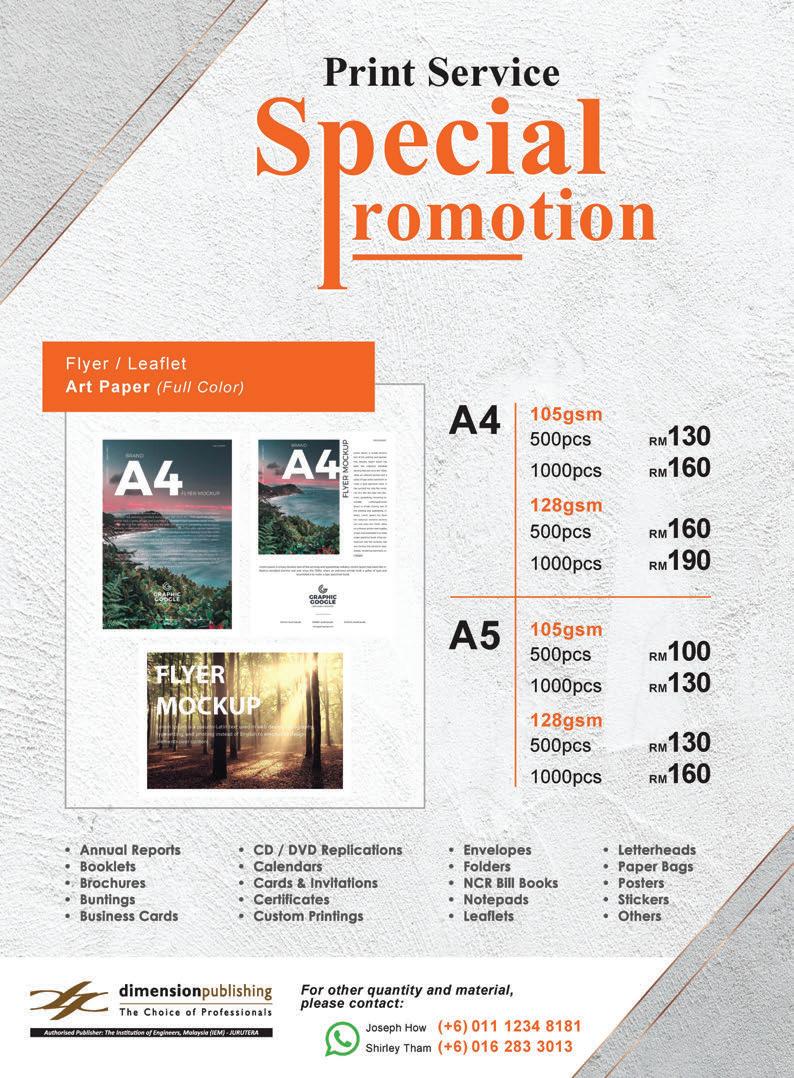

Written and Prepared by:

YB. Tuan Chang Lih Kang, Minister of Science, Technology & Innovation inaugurated the 34th International Invention & Innovation Exhibition (ITEX) which highlighted the outcomes of Innovation Education in May 2023. Many young inventors from various institutions, both local and foreign, were present to present their innovations and ideas.
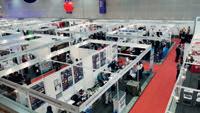

ITEX had taken proactive steps to address the climate crisis by bringing together inventive minds from around the world to create sustainable climate technology solutions.
Tuan Chang said he was excited about the impact to be obtained through ITEX in dealing with climate change. He said: “As the theme is Technology Reversing Climate Change, I am excited to see innovative new solutions which have been built based on energy efficient technology or using renewable energy sources, reducing carbon emissions and using recycled or recyclable materials.”
He was also proud of the role that ITEX had played in advancing invention and innovation in the country and
encouraging the growth of local creators as this was in line with Creativity, one of the core aims of Malaysia MADANI. The exhibition went hand in hand with the Government’s desire to spearhead future-oriented policies designed to stimulate local creativity and expertise, as well as to empower the people in developing solutions engineered towards a peaceful and prosperous country.
The two-day exhibition received over 700 entries with more than 80% focussing on climate technology solutions. Local institutions and individuals made up nearly 60% of the participants who had come from 19 countries and regions.
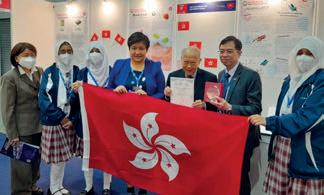


The ASEAN Electrotechnical Symposium & Exhibition (IESE 2023), held on 6-7 September 2023 at Plenary Theatre, Kuala Lumpur Convention Centre, centred on the theme, Standards Drive ESG Excellence. It was jointly organised by The Institution of Engineers, Malaysia, Standards Malaysia and Suruhanjaya Tenaga (Energy Commission of Malaysia). Officiating at the event was YBhg. Datuk Seri Isham bin Ishak, Secretary General, Ministry of Investment, Trade & Industry. A total of 14 speakers were invited to speak on various related topics. The second day featured a forum on Sustainable Energy Solutions & Green Technology, where experts engaged

in discussions on ESG, electric vehicle (EV) development, electrical standards, safety, energy efficiency and energy audit.
Taking part were engineering professionals, government officials and policymakers, standards organisations, manufacturers, suppliers and solution providers as well as owners and operators from both domestic and ASEAN countries. They participated in the four individual sessions on the following topics: Standards Drive ESG Excellence, Energy Efficient Buildings, Climate Change & Carbon Footprint Reduction and ASEAN Power on Electrical Standards.
The Safety in Engineering Symposium 2023, hosted by the Safety in Engineering Special Interest Group under the patronage of The Institution of Engineers, Malaysia, was an enlightening and impactful event. Held under the guidance of organising chairman Dr Ong Chong Yong, it brought together enthusiastic participants from various backgrounds, including an academician, practising engineers, developers, contractors, consultants, manufacturers and the authorities.
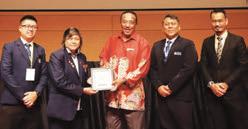
The guest of honour was Ir. Zamzurin bin Maarof (Director of Department of Occupational Safety and Health Wilayah Kuala Lumpur & Putrajaya) who officiated at the event. The success of the event could be attributed to the involvement and support from sponsors, honourable speakers, participants and the organising committee.
Key highlights in SES 2023 included presentations on OSCHIM, innovative safety technologies, risk assessment methodologies,
and case studies on safety mishaps and their preventive measures.

The vision of the upcoming Safety in Engineering Symposium (SES) is to champion a transformative culture within the engineering community, one in which safety is paramount. We aspire to create an environment of robust knowledge exchange, embracing innovation in safety technologies and methodologies. Through education and heightened awareness, we aim to empower engineers to proactively embed safety in every facet of their work.
The symposium seeks to bridge local and global collaboration, uniting diverse engineering professionals to collectively address safety challenges. The ultimate goal is to propel the industry toward a future where engineering projects are synonymous with safety, thus ensuring a safer, more secure world for all. Come join us at Safety in Engineering Symposium 2024.


The main organiser for IRASD’2023 is IEM Civil and Structural Engineering Technical Division (CSETD), supported by Swinburne University of Technology Sarawak, The University of Hong Kong, Monash Malaysia, IStrctE Malaysia Chapter and Concrete Society of Malaysia. A total of about 140 participants attended the one-day symposium at KLCC plenary theatre on 8 September 2023, in conjunction with the IEM Convention 2023.
The 1st Malaysia China Engineering Digital Transformation Summit 2023, with the theme, Convergence of Digital Transformation & Sustainability, was held on 8 September 2023 at the KL Convention Centre in Kuala Lumpur, based on a hybrid version. It was jointly organised by the Institution of Engineers Malaysia, Infrastructure University Kuala Lumpur (IUKL), Huaqiao University, TusStar Malaysia, The Federation of Chinese Associations Malaysia (Huazong), Chinese Mechanical Engineering Society Malaysia Chapter and ASEAN Engineering Inspector for Manufacturing.
The sub-themes were Women in Digital Transformation, Belt & Road initiative, Digital Organisation, Digital Process & Technology and Sustainability. The welcome speech was delivered by the IUKL President/ViceChancellor YBhg. Dato’ Prof. Dr Noor Inayah binti Ya'akub and IEM President Ir. Prof. Dr Norlida binti Buniyamin. The Distinguished Opening Guest of Honour was YBhg. Academician Dato’ Ir. Dr Lee Yee Cheong, the Honorary Chairman of International Science Technology & Innovation Centre for South-South Cooperation under the

Following the first IRASD’2019 held in Hong Kong, the IRASD’2023 is to resume the series after four years, bringing nine distinguished speakers, with a balance of academics and practitioners from Australia, Hong Kong, Singapore and Malaysia to share with the Malaysian engineering community on the updated knowledge of structural design of building structures in regions of low-tomoderate seismicity.
The topics presented by the speakers include free online seismic analysis tools, design of shear walls and coupling beams, seismic assessments, post-installed rebars, precast concrete connections, high damping rubber in bridges, philosophical design for tall buildings in low seismic but strong wind regions and geotechnical seismic isolation.
It was observed that many practicing engineers were interested in the tall building seismic design and directed the questions to speakers like Dr Goman Ho, Dr Kam, Dr Ray Su and Prof. Nelson Lam. Some feedback received from student participants was that the topic of geotechnical seismic isolation was interesting.

auspices of UNESCO (ISTIC), KL. The Distinguished International Keynote Speaker was Prof. Dr Shahbaz Khan. The honorary Keynote Speaker was Dr Pei Huang, Deputy Secretary General of the International Coalition of Intelligent Manufacturing. The organising Chair of the Summit was YBhg. Dato’ Prof. Dr Noor Inayah binti Ya'akub, President/ViceChancellor of IUKL; she was assisted by Ir. Ts. Prof. Dr Tan Chee Fai, Deputy Vice-Chancellor, IUKL and Vice President of IEM.


The participants were from ASEAN countries, Asia Pacific and African countries. Counsellor Zhao Xiangdong of the Chinese Embassy in Malaysia visited the summit to give support. There were 30 panellists from various organisations such as National Aerospace Industry Corporation Malaysia, MATRADE, IUKL, Huazong, Malaysia Productivity Corporation, Malaysian National Computer Confederation, Malaysia Association of Sustainable Supply Chain & Innovation, Small & Medium Enterprises Association of Malaysia, IEM, Huaqiao University, University of Glasgow and IEEE Malaysia.
The new Malaysia National Industrial Master Plan and various topics in digital transformation and sustainability were discussed during the forum.
The 2nd edition of Project Management Conference (PROMAC) 2023 took place on 9 September 2023 at the Kuala Lumpur Convention Centre, in collaboration with IEM Engineer’s Week. The theme was Advancing Project Management: Agile and Beyond 2023.
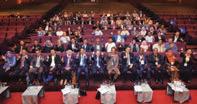
The welcome speech was delivered by IEM Deputy President Ir. Prof. Dr Jeffrey Chiang Choong Luin. Following this, the Guest of Honour, YBhg. Datuk Ir. Ahmad Redza bin Ghulam
Rasool, the Director General of Jabatan Kerja Raya (JKR) Malaysia, delivered a thought-provoking keynote address titled Agile and New Ways of Project Management, setting the tone for the entire conference.
PROMAC 2023 focused on three core sub-themes, each of which played a pivotal role in shaping the discussions and insights shared during the conference:
The Smart & Sustainability Cities Engineering Symposium 2023 (SSCES 2023) was held on 9 September 2023 at the KL Convention Centre, Kuala Lumpur. With Advancing the Future of Smart & Inclusive Developments as its main theme, the event was organised by the Urban Engineering Development Special Interest Group of The Institution of Engineers, Malaysia (IEMUEDSIG).
IEM-UEDSIG would like to express its gratitude to the guest of honour, YBrs. TPr. Md. Nazri bin Abdullah, the Deputy Director (Planning) of the Federal Department of Town & Country Planning Malaysia (PLANMalaysia). He was accompanied by IEM Vice President Ir. Yau Chau Fong at the opening ceremony. The support given by PLANMalaysia at SSCES 2023 shows its dedication and readiness to catalyse the future advancement of the smart cities planning and development in the country.
The hybrid symposium was attended by 124 physical participants and 178 virtual attendees who came from various backgrounds, including Government Body GLC Institution Consultants and Contractors from Malaysia and Indonesia, Developers, Universities Professors, Lecturers, Sponsors Representatives from Danfoss Malaysia Sdn Bhd, Veolia Water (Malaysia) Sdn Bhd, IJM Corporation Sdn Bhd, AAE Solution Sdn Bhd, Ecolink Engineering Sdn Bhd, BSS Development Sdn Bhd, Danfoss Malaysia Sdn Bhd, Ecolink Engineering Sdn Bhd, AAE Solution Sdn Bhd, Hisense (Malaysia) Sdn Bhd, SaveLite Engineering Sdn Bhd and PLUS PM Consultant Sdn Bhd.
Theme 1: Governance and Integrity in Managing Projects.
Theme 2: Adapting to the Post-Pandemic Era: Embracing Digitalisation in Project Delivery.
Theme 3: Agility in Supporting Sustainability Initiatives: Energy, Renewable Resources and Low Carbon Economy.

There was active participation from the 145 delegates; 105 attended in person and an additional 40 joined in virtually. This hybrid approach ensured that our valuable insights could reach a more diverse and broader audience.
The Organising Committee extends its deepest gratitude to the platinum sponsors, Affin Bank Berhad and Bina CloudTech Sdn Bhd., whose unwavering support and commitment have helped make the conference a huge success. We also applaud the entire organising team whose dedication, hard work and tireless efforts have made PROMAC 2023 a reality.
Together, we are not merely shaping Project Management in Malaysia but we are also paving the way for innovation, excellence and sustainable progress in the industry. As we look forward to future editions of PROMAC, we are confident that the momentum and enthusiasm generated by this event will continue to drive positive change and elevate the field of Project Management in Malaysia and beyond.


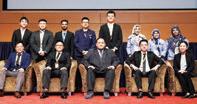
The speakers’ topics highlighted three main aspects – Smart, Sustainable and Engineering – which facilitated the future of living in the concept of a smart city. Speakers shared their experiences and insights into the current technologies of smart, sustainable cities, the challenges they faced and the future trend in smart cities development. The development of smart and sustainable cities will focus on decarbonisation through carbon footprint reduction programmes such as green building design, energy generation transition, circular economy and lowering the dependency on fossil fuels in future. With the participation of TNBX Sdn. Bhd., participants were exposed to smart and innovative solutions in renewable energy and energy efficiency for homes and businesses towards achieving net-zero target.
SSCES 2023 served as a pivotal platform for the exchange of ideas, experiences and insights into smart and sustainable city development. Here are some highlights during the event:
• Energy transition
• Green building design
• Advance technologies focusing on energy efficiency
• Sustainable conscious community
• Citizen centric smart cities.





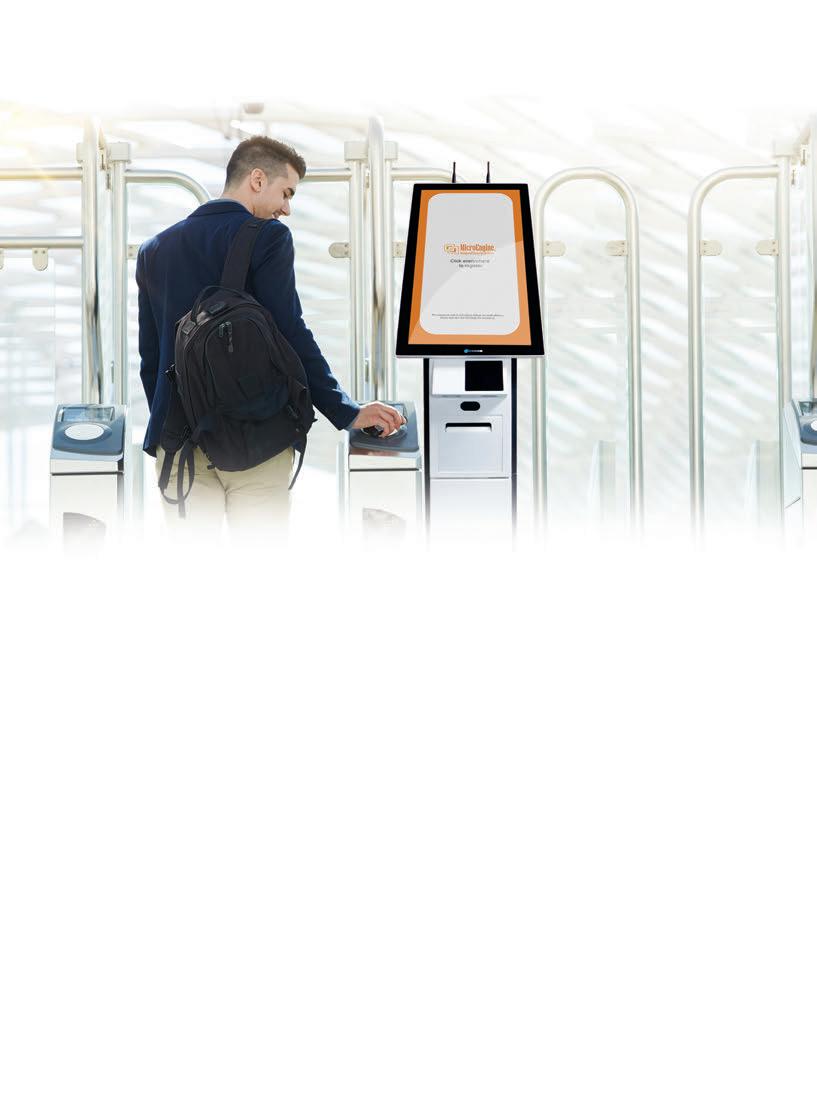


Chemicals are pervasive in our daily lives, contributing to various industries such as manufacturing, agriculture, healthcare, and research. While they are essential, improper handling and management of chemicals can lead to serious hazards for human health and the environment. Herein, we briefly explore the fundamental principles of chemical safety, with a focus on the applicable Malaysian laws and regulations governing their safe use and management.
Understanding Chemical Hazards
It is crucial to grasp the various hazards associated with chemicals. This is imperative so we can comprehend and thus protect and prevent ourselves from chemical hazards. Chemical hazards can be broadly categorised into four (4) main types that are (i) physical, (ii) health, (iii) environmental and (iv) biological hazards. Physical hazards encompass properties like flammability, explosiveness, reactivity, and corrosiveness. Chemicals with physical hazards can lead to immediate dangers if not handled with care. Chemicals can also pose risks to human health, potentially
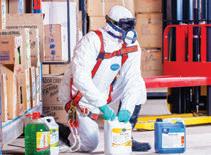

causing toxicity, carcinogenicity, or other adverse health effects, and this falls under health hazards category. Environmental hazards occur when some chemicals harm the environment by polluting soil, water, and air. They may also accumulate in ecosystems, causing long-term harm to biodiversity. Finally, biological hazards happen when certain chemicals harbour biological risks, such as promoting the growth of harmful microorganisms if not stored or handled correctly.
Basic Principles of Chemical Safety
It's essential to embrace fundamental principles of chemical safety when working with or around chemicals. The following are the key basic principles of chemical safety:
1. Hazard Identification and Classification
Recognise and classify chemicals according to their hazards. Ensure proper labeling, safety data sheets, and hazard communication, and following the Global Harmonized System (GHS) guidelines and local regulations.
2. Risk Assessment
Conduct thorough risk assessments for chemical handling and storage activities. Identify potential hazards, evaluate the risks, and implement appropriate control measures.
3. Personal Protective Equipment (PPE)
Provide and use appropriate PPE, such as gloves, goggles, lab coats, and respirators, as needed to protect against chemical exposure.
4. Safe Handling and Storage
Follow recommended handling and storage practices to prevent accidents, chemical reactions, and environmental contamination. Store chemicals in compatible containers and storage areas.
5. Emergency Preparedness
Develop and implement emergency response plans, including spill containment procedures and first aid protocols, to minimise harm in case of accidents.
6. Training and Education
Ensure that all individuals working with chemicals receive proper

Written and Prepared by:

training on safe handling, storage, and disposal practices in compliance with Malaysian regulations.
7. Environmental Responsibility Emphasize responsible chemical management by adhering to environmental laws and regulations. Dispose hazardous waste in accordance with DOE guidelines and schedule waste management practices.
Applicable Malaysian Laws and Regulations
Key laws and regulations that govern chemical safety in Malaysia include:
• Occupational Safety and Health Act 1994 (OSHA 1994)
• Environmental Quality Act 1974 (EQA 1974)
• Use and Standard of Exposure Chemical Hazardous to Health Regulations 2000 (USECHH Regulations)
• Chemical Health Risk Assessment (CHRA)
• Globally Harmonised System of Classification and Labelling of Chemicals (GHS)
Conclusions
In sum, prioritising chemical safety is crucial for safeguarding both human lives and the environment. By adhering to rigorous safety protocols, conducting risk assessments, and enforcing regulations, we can minimise the potential hazards posed by chemicals. Preserving our health and the planet's well-being is a shared responsibility. Embracing these essentials is an essential step towards a safer and more sustainable future for all.
Kepada Semua Ahli,
Tarikh: 18 Oktober 2023
SENARAI CALON-CALON YANG LAYAK MENDUDUKI TEMUDUGA PROFESIONAL TAHUN 2023
Berikut adalah senarai calon yang layak untuk menduduki Temuduga Profesional bagi tahun 2023.
Mengikut Undang-Undang Kecil IEM, Seksyen 3.8, nama-nama seperti tersenarai berikut diterbitkan sebagai calon-calon yang layak untuk menjadi Ahli Institusi, dengan syarat bahawa mereka lulus Temuduga Profesional tahun 2023.
Sekiranya terdapat Ahli Korporat yang mempunyai bantahan terhadap mana-mana calon yang didapati tidak sesuai untuk menduduki Temuduga Profesional, surat bantahan boleh dikemukakan kepada Setiausaha Kehormat, IEM. Surat bantahan hendaklah dikemukakan sebulan dari tarikh penerbitan dikeluarkan.
Ir. Prof. Dr Zuhaina binti Zakaria Setiausaha Kehormat, IEM
PERMOHONAN BARU
Nama Kelayakan
KEJURUTERAAN AWAM
AZMIR BIN ISHAK BE (UTM) (CIVIL, 2017)
KEJURUTERAAN ELEKTRONIK
ASHVAANY A/P EGAMBARAM BE (UMP) (ELECTRICAL (ELECTRONIC), 2009) ME (UM) (ELECTRONIC, 2012) PhD (UTP) (2020)
KEJURUTERAAN MEKANIKAL
ROHAIZAD BIN JAMALUDIN BE HONS (UTM) (MECHANICAL, 2004) ME (UM) (MANUFACTURING, 2015)
PERMOHONAN MENJADI AHLI KORPORAT
Nama Kelayakan
KEJURUTERAAN AWAM
TAN CHEE YEE BE (UTM) (CIVIL, 2001) MSc (UPM) (STRUCTURAL AND CONSTRUCTION, 2003)
PERPINDAHAN AHLI
No. Ahli Nama Kelayakan
KEJURUTERAAN KIMIA
27418 MOHD FAIZAN BIN JAMALUDDIN BE (UMP) (CHEMICAL, 2009) ME (UMP) (BIO-PROCESS, 2013) PhD (UMP) (2021)
89696 SITI NOOR SUZILA BINTI MAQSOOD UL HAQUE BE HONS (UTM) (CHEMICAL, 2006) ME (UTM) (CHEMICAL, 2007) PhD (UNSW) (2013)
KEJURUTERAAN AWAM
123655 CHIN JOON FUI BE (UMP) (CIVIL, 2013)
84270 LEE SHEE ZIE BE (UTM) (CIVIL, 2018)
33564 MOHAMMAD LUFMAN BIN SABRI BE HONS (UTM) (CIVIL, 2009)
115734 NORLIDA BINTI RAMLEE BE HONS (UTHM) (CIVIL, 2014)
62163 NORSHAZWINA BINTI JOHARI BE (UTM) (CIVIL, 2012) ME (UTM) (GEOTECNICAL, 2017)
111319 SUHAILY BINTI SALEH BE HONS (UTM) (CIVIL, 2014)
78478 YEW CHOO YANG BE HONS (UMS) (CIVIL,2012)
KEJURUTERAAN KOMUNIKASI
113134 MUHAMMAD HAFIYFIY BIN SAFRI BE (QUEENSLAND) (ELECTRICAL, 2015)
KEJURUTERAAN ELEKTRIK
96913 LEE XIAN HUAI BE HONS (NOTTINGHAM) (ELECTRICAL AND ELECTRONIC, 2015) MSc (STAFFORDSHIRE) (ELECTRICAL, 2016)
73728 MUHAMMAD ZUHDI BIN CHE RAHIM BE HONS (UTeM) (ELECTRICAL, 2018)
KEJURUTERAAN ELEKTRONIK
21028 ANWAR BIN MOHD ABD MAHI BE HONS (UTM) (ELECTRICAL, 2001) ME (UTM) (ELECTRICAL-MECHATRONICS & AUTOMATIC CONTROL,2013)
KEJURUTERAAN MEKANIKAL
103635 WONG SOONG SENG BE HONS (SUNDERLAND) (MECHANICAL, 1997)
KEJURUTERAAN PETROLEUM
87171 CHEONG ING KEITH BSc (COLORADO SCHOOL OF MINES) (PETROLEUM, 2010)
PERPINDAHAN MENJADI AHLI KORPORAT No. Ahli Nama Kelayakan
KEJURUTERAAN KIMIA
94131 MOHD AMINUDIN BIN MANSOR BE (UTM) (CHEMICAL, 2008)
77956 NG KAY LUP, ANDREW BE HONS (UTAR) (CHEMICAL, 2016) PhD (UM) (2019)
KEJURUTERAAN AWAM
67778 DZULHILMI BIN ZULKIFLI BE HONS (UTM) (CIVIL (INFRASTRUCTURE), 2016) MSc (USM) (PROJECT MANAGEMENT, 2022)
105667 LIEW ZHEN MIN, EDMUND BE HONS (UCSI) (CIVIL, 2018)
85532 TIE TZER SHENG BE HONS (IUKL) (CIVIL, 2017) MSc (UM) (CIVIL, 2022)
KEJURUTERAAN ELEKTRIKAL
112882 WONG KOK HONG BE HONS (UTeM) (ELECTRONICS (COMPUTER ENGINEERING), 2011)
KEJURUTERAAN MEKANIKAL
100912 ONG JING YUAN BE HONS (UTAR) (MECHANICAL, 2018)
Pengumuman yang ke-180
SENARAI PENDERMA KEPADA WISMA DANA BANGUNAN IEM
Institusi mengucapkan terima kasih kepada semua yang telah memberikan sumbangan kepada tabung Bangunan Wisma IEM. Ahli-ahli IEM dan pembaca yang ingin memberikan sumbangan boleh berbuat demikian dengan memuat turun borang di laman web IEM http://www.myiem.org.my atau menghubungi secretariat di +603-7968 4001 / 5518 untuk maklumat lanjut. Senarai penyumbang untuk bulan September 2023 adalah seperti jadual di bawah:
NO. NO. AHLI NAMA
1 19096 Ir. SHYAM LAKSHMANAN
2 26970 MR. S. VEERAKUMAR A/L S. SUBRAMANIAM
3 38354 MR. AZALAN BIN AHMAD
Heartiest Congratulations to
YBhg. First Admiral (R) Dato’ Ir. Hj. Ahmad Murad bin Hj. Omar on his appointment as President of Maritime Strategic Association of Malaysia (MASTRA) for session of 2023 - 2025.
YBhg. Dato’ Ir. Dr Dennis Ganendra who has been awarded the prestigious British Royal Academy of Engineering (RAE) International Fellowship for Outstanding Engineering Contributions.
CONTINUATION FROM OCTOBER ISSUE 2023
PERMOHONAN MENJADI AHLI (MELALUI PEPERIKSAAN PENILAIAN PROFESIONAL)
No. Ahli Nama Kelayakan
KEJURUTERAAN AWAM
118565 ERZAL AZDIDI BIN KAMBALI BE HONS (UiTM) (CIVIL, 2010)
118564 FAUZIAH BINTI SIPLI BE HONS (UiTM) (CIVIL, 2009)
118690 LIM HOCK HOO ME HONS (LONDON) (CIVIL, 2007)
118561 MOHAMED SHAHROM BIN HISHAM BE HONS (UTM) (CIVIL, 2000)
118849 MOHD SHAHRUL EFFENDY BIN AHMAD BE HONS (UTM) (CIVIL, 2008)
KEJURUTERAAN ELEKTRIKAL
118562 MUHAMMAD ZAMIR BIN MOHD ZAMBERI BE HONS (UTM) (ELECTRICAL, 2007)
KEJURUTERAAN KIMIA
118689 CHONG CHIEN LOONG BE HONS (UKM) (CHEMICAL, 2012)
118566 SUHAIMI BIN DERAMAN BE HONS (SHEFFIELD) (CHEMICAL PROCESS & FUEL TECHNOLOGY, 1991)
KEJURUTERAAN MEKANIKAL
118691 HAZRY BIN DESA BE (TOKUSHIMA) (MECHANICAL, 1997) PhD (OITA) (2007)
118563 MOHD NAJIB BIN TUGIMAN BE HONS (UiTM) (MECHANICAL, 2002)
PEMINDAHAN KEPADA AHLI 'SENIOR'
No. Ahli Nama Kelayakan
KEJURUTERAAN ELEKTRONIK
89716 RAVINTHRAN A/L MARIAPPAN (Dr) B.E.HONS.(UKM) (ELECTRICAL, ELECTRONIC & SYSTEM, 2000) M.Sc.(UNITAR) (INFORMATION TECH., 2008) PhD.(OUM)(BUSINESS ADMINISTRATION, 2014)
KEJURUTERAAN MEKANIKAL
58699 MOHD AZHARI BIN MOHD RODZI BSc HONS (RENSSELAER POLYTECHNIC INSTITUTE) (MECHANICAL, 2012) MSc (UiTM) (MECHANICAL, 2017)
PERMOHONAN KEPADA AHLI 'SENIOR GRADUATE' No. Ahli Nama Kelayakan
KEJURUTERAAN AWAM
118453 TIONG KUNG LEONG BE HONS (UTM) (CIVIL, 2006) PhD (UTM) (2014)
118973 LEE PEI CHOW BE HONS (UTM)(CIVIL, 2007)
118457 THONG WEI YUNG BE HONS (USM) (CIVIL, 2005)
118452 ADNAN BIN AZIZ BE HONS (UTM) (CIVIL, 2001)
118707 AHMAD SELIHIN BIN CHE SAID BE HONS (UNIMAS)(CIVIL, 2002)
KEJURUTERAAN ELEKTRIKAL
118451 SHERYWINA STEPHEN BE HONS (UMS) (ELECTRICAL & ELECTRONICS, 2011)
118704 ALFRED KUMBAR DAULIN BE HONS (UMS)(ELECTRICAL & ELECTRONICS, 2011)
118706 LIAW CHONG BENG BE HONS (SWINBURNE UNI. OF TECH.)(ELECTRICALCOMMUNICATION & ELECTRONICS, 1992)
KEJURUTERAAN ELEKTRONIK
118705 CHUA SING YEE BE HONS (UTM)(ELECTRICALELECTRONICs, 2005) PhD (MONASH UNI.)(2017)
KEJURUTERAAN MEKANIKAL
118972 ABDUL RAHMAN BIN SAYED ABDULLAH BE HONS (UNITEN) (MECHANICAL, 2012)
118456 LAI HIN WAI BE (ADELAIDE) (MECHANICAL, 2002)
118455 LOW SAINT YOUNG BE HONS (UPM) (MECHANICAL, 2002)
20634 JOLLIFFE ANAK NICHOLAS MUYA BE HONS (UiTM(MECHANICAL, 2001)
118454 MOHD RAZIF BIN IDRIS BSc HONS (SUNDERLAND) (MECHANICAL, 1987) PhD (PORTSMOUTH) (2007)
PERMINDAHAN KEPADA AHLI SISWAZAH
No. Ahli Nama Kelayakan
KEJURUTERAAN ALAM SEKITAR
117336 FONG RUI QIAN BE HONS (UTAR KAMPAR) (ENVIRONMENTAL, 2022)
KEJURUTERAAN AWAM
97756 LAU CHUN WEI, RASLEY BE HONS (CITY UNI.)(CIVIL, 2020)
94526 WONG WILSON BE HONS (CURTIN UNI.)(CIVIL & CONSTRUCTION, 2022)
90248 AHMAD KAMIL BIN AMIRUDDIN BE HONS (IIUM)(CIVIL, 2019)
68947 JOANNA ANAK ALI BE HONS (UiTM)(CIVIL, 2016)
81614 LOW YONG LER BE HONS (UMP)(CIVIL, 2018)
88915 ASNIDAH BINTI ARIF ABDULLAH BE HONS (UMS)(CIVIL, 2018)
52112 LIM MEI SHING, MICHELLE BE HONS (UNIMAS)(CIVIL, 2015)
102116 CHING LIANG YI BE HONS (UTAR SG LONG) (CIVIL, 2022)
104417 MANDY SO SHYUN BE HONS (UTAR SG LONG) (CIVIL, 2022)
68715 AZIZUL BIN SHAARI BE HONS (UTHM) (CIVIL, 2015)
92768 LEE MING YUAN BE HONS (UTM)(CIVIL, 2020)
21258 LEE HONG KIAT BE HONS (UTM)(CIVIL, 2022)
KEJURUTERAAN ELEKTRIKAL
90967 THANG WEN WAI, ERIC BE HONS (USM)(ELECTRICAL, 2020)
35519 LIM LIEN TZE BE HONS (UTAR)(ELECTRICAL & ELECTRONIC, 2009) PhD (UPM)(PHOTONICS & FIBER OPTIC SYSTEMS, 2016)
63161 NUSHENTHAN NAIDU A/L CHANDREN BE HONS (UTeM) (ELECTRICAL, 2016)
63022 MOHAMMAD FITRI ASNAWI BIN ROSMAN BE HONS (UTeM) (ELECTRICAL-INDUSTRIAL POWER, 2017)
48723 GOH ZAI PENG BE HONS (UTHM) (ELECTRICAL, 2013) PhD (UPM)(2017)
KEJURUTERAAN KIMIA
80768 WONG WAI CHUNG BE HONS (CURTIN UNI.) (CHEMICAL, 2018)
KEJURUTERAAN MEKANIKAL
71052 PHUA YEONG SIANG BE HONS (KDU UNI.COLL. ) (MECHANICAL, 2018)
109605 YEOH CHEN WEI BE HONS (TARC) (MECHANICAL, 2021)
116493 MUHAMMAD FARHAN BIN ROSLAN BE HONS (THE UNI. OF NEW SOUTH WALES) (MECHANICAL, 2022)
76011 DINIE BIN ABDULLAH ZAMAWI BE HONS (UiTM) (MECHANICAL, 2018)
97696 NAJWA SYAKIRAH BINTI HAMIZAN BE HONS (UiTM) (MECHANICAL, 2020)
51755 NG CHAW SING BE HONS (UKM) (MECHANICAL, 2016)
105885 LIM DAO YUAN BE HONS (UTAR SG LONG) (MECHANICAL, 2022)
104397 TAN CHUN WEN BE HONS (UTAR SG LONG) (MECHANICAL, 2022)
107703 TAI KHAI XIEAN BE HONS (UTAR SG LONG) (MECHANICAL, 2022)
93385 MOHAMAD SHAFIQ ALI BIN MOHAMED HASSAN ALI BE HONS (UTM) (MECHANICAL, 2020)
60466 SUE WEI PING BE HONS (UTP)(MECHANICAL, 2015)
70734 VOON FOO CHUAN BSc HONS (UMP) (MECHANICAL, 2016)
KEJURUTERAAN PEMBUATAN
109704 TIE WEITING KENRICK BE HONS (UTAR SG LONG)(MATERIALS & MANUFACTURING, 2022)
102128 NG JIA JUN BE HONS (UTAR SG LONG)(MATERIALS & MANUFACTURING, 2022)
75142 AMMAR FAKHRULLAH BIN ARIFIN BE HONS (UTeM) (MANUFACTURING, 2019)
PERMOHONAN MENJADI AHLI SISWAZAH No. Ahli Nama Kelayakan
KEJURUTERAAN AEROANGKASA
119004 STEVENSON BIN GURAMUN BE HONS (USM)(AEROSPACE, 2005)
KEJURUTERAAN ALAM SEKITAR
119740 LOO YI XIN BE HONS (UTAR KAMPAR) (ENVIRONMENTAL, 2022)
119739 PAN DE WEI BE HONS (UTAR KAMPAR) (ENVIRONMENTAL, 2022)
119738 TAN SIN YING BE HONS (UTAR KAMPAR) (ENVIRONMENTAL, 2022)
119737 TAN YU HENG BE HONS (UTAR KAMPAR) (ENVIRONMENTAL, 2022)
119736 WARREN TONG MENG WEI BE HONS (UTAR KAMPAR) (ENVIRONMENTAL, 2022)
KEJURUTERAAN AUTOMOTIF
118959 AUDREY WOON SU FERN BE HONS (UNI. OF HERTFORTSHIRE) (AUTOMOTIVE, 1998)
KEJURUTERAAN AWAM
118433 CHUA CHUNG CHEAK, REX BE HONS (CURTIN UNI. OF TECH.)(CIVIL & CONSTRUCTION, 2008)
118413 HO KIEN BING, SAMUEL BE HONS (CURTIN UNI.)(CIVIL & CONSTRUCTION, 2021)
119027 NOR AMEERA TASHA BINTI KAMARULBAHRIN BE HONS (IIUM)(CIVIL, 2020)
118446 TAN JIN SOON BE HONS (INTI INTERNATIONAL UNI.)(CIVIL, 2017)
118702 CHUNG XIANG ZHI BE HONS (IUKL)(CIVIL, 2017)
118436 MOHAMAD ASRUL BIN RAMLY BE HONS (IUKL)(CIVIL, 2017)
118445 AVINASH RAM A/L KERTARA RAM BE HONS (KUTTHO)(CIVIL, 2006)
118424 NG SHU MIN BE HONS (MONASH UNI.) (CIVIL, 2021)
119017 NG CHEE XUAN BE HONS (MONASH UNI.) (CIVIL, 2022)
118425 CHUNG YUAN LIN, KENNETH BE HONS (SWINBURNE UNI. OF TECH.)(CIVIL, 2016)
118982 ALBERT CHAI JIIN TSONG BE HONS (SWINBURNE UNI. OF TECHNOLOGY)(CIVIL, 2017)
119020 WONG SE CHENG BE HONS (SWINBURNE UNI. OF TECHNOLOGY)(CIVIL, 2018)
119028 NAZIA OTHMAN BIN YAHYA BE HONS (THE UNI. OF BIRMINGHAM)(CIVIL, 1999)
118430 NATASSHA MAE WILIS BE HONS (THE UNI. OF SHEFFIELD)(CIVIL, 2018) MSc (UNI. OF BIRMINGHAM) (ROAD MANAGEMENT & ENGINEERING, 2019)
118442 KHOR KHER LEE BE HONS (UCSI UNI.)(CIVIL, 2021)
118943 MUHAMMAD ZARUL AIMAN BIN ZAMREE BE HONS (UiTM)(CIVIL, 2017)
118945 NUR LOKMAN BIN LOKENG BE HONS (UiTM)(CIVIL, 2017)
118708 NUR SYAMIN FATIHAH BINTI JOHARI@BAHA BE HONS (UiTM)(CIVIL, 2021)
118419 MOHAMAD SYAZWAN BIN RADZI BE HONS (UKM)(CIVIL, 2021)
119016 RUBENDHRAN A/L THAMBIRAJAH BE HONS (UKM)(CIVIL, 2021)
119011 COLIN HO WAI HON BE HONS (UKM)(CIVIL, 2021)
118992 MUHAMMAD BIN ALI BE HONS (UMP)(CIVIL, 2013)
119012 MUHAMMAD IBRAHIM ADHAM BIN GHAZALI BE HONS (UMP)(CIVIL, 2018)
119000 THIEW JIH HERNG BE HONS (UMP)(CIVIL, 2021)
118957 JULINDA HENA JUOH BE HONS (UMS)(CIVIL, 2008)
118427 IGNATIA PIUS BE HONS (UMS)(CIVIL, 2020)
119005 LIM CHOON KIAT BE HONS (UNI. OF NOTTINGHAM)(CIVIL, 2010) MSc (UNI. OF NOTTINGHAM) (CIVIL, 2012)
118950 ALEX LIAW TZE WEI BE HONS (UNI. OF PORTMOUTH)(CIVIL, 2014) MSc (UNI. OF PORTMOUTH) (CONSTRUCTION PROJECT MANAGEMENT, 2015)
118981 MOHAMED INAS KAMEL BIN AKBAR BATCHA BE HONS (UNIMAP)(CIVIL, 2020)
119006 VANESSA ANAK GOLAYOUS BE HONS (UNIMAS)(CIVIL, 2013)
118441 MUHAMMAD ZUL FATHI BIN AHMAD ZAWAWI BE HONS (UNITEN)(CIVIL, 2021)
118703 KIING SIE WEI BE HONS (UNSW)(CIVIL, 1989)
118426 TEH SEK YEE BE HONS (UNSW)(CIVIL, 2012)
119759 GOH YEE HAO BE HONS (UTAR SG LONG) (CIVIL, 2022)
119757 LIM HAN YUEN BE HONS (UTAR SG LONG) (CIVIL, 2022)
119751 WANG WEI DONG BE HONS (UTAR SG LONG) (CIVIL, 2022)
118996 CHUA YI WEI BE HONS (UTAR)(CIVIL, 2019)
118958 TEO JIEN SHENN BE HONS (UTAR)(CIVIL, 2020)
118516 ARUMUGAM A/L MUNIAPPAN BE HONS (UTM)(CIVIL, 2000)
118991 NORSYAZMIRA BINTI NORZAID BE HONS (UTM)(CIVIL, 2016)
118994 AMIRUL ASYRAF BIN MOHAMMAD BE HONS (UTM)(CIVIL, 2017)
118439 ABDUL RASAD BIN PATAWI BE HONS (UTM)(CIVIL, 2021)
118979 MOHD ZAKI BIN DERAMAN BE HONS (UTM)(CIVIL, 2021)
118949 MOHD RAFI BIN MOHAMED SULAIMAN BE HONS (UTM)(CIVIL, 2021)
118414 AMIR MOHAMMAD ALIZADA BSc (MARSHAL FAHIM NATIONAL DEFENCE UNI.) (CIVIL, 2021) MSc (UiTM)(STRUCTURAL, 2021)
118997 YAP CHUN KEAT ME HONS (HERIOT-WATT UNI.) (CIVIL, 2020)
118709 TEE RUI JIAN ME HONS (ICL)(CIVIL, 2019)
118437 LAU LEE WAY ME HONS (THE UNI. OF NOTTINGHAM)(CIVIL, 2020)
118448 NG KAI JIA ME HONS (THE UNI. OF NOTTINGHAM)(CIVIL, 2021)
119008 LYE JIN HONG ME HONS (UNI. OF NOTTINGHAM)(CIVIL, 2019)
KEJURUTERAAN BIO-PERUBATAN
119763 BOO SHANE PINK BE HONS (UTAR SG LONG) (BIO-MEDICAL, 2022)
119760 GAN FEI YING BE HONS (UTAR SG LONG) (BIO-MEDICAL, 2022)
119756 LOW SHIH YI BE HONS (UTAR SG LONG) (BIO-MEDICAL, 2022)
KEJURUTERAAN ELEKTRIKAL
118984 HUI WAI YAN BE HONS (UCSI)(ELECTRICAL & ELECTRONIC, 2019)
118435 TAN HONG TZUAN, GABRIEL BE HONS (UKM)(ELECTRICAL & ELECTRONIC, 2021)
119026 VIJANDRAN MANIAM BE HONS (UMP)(ELECTRICAL, 2015)
119010 LOW KOK HIN BE HONS (UMP)(ELECTRICALPOWER SYSTEM, 2017)
118954 MUHAMMAD ARIF BIN MOHD YUSDI BE HONS (UMP)(ELECTRICALPOWER SYSTEM, 2020)
118976 TIRUVARASU A/L ARJUNAN BE HONS (UNI. OF LEICESTER) (ELECTRICAL & ELECTRONIC, 1992)
118980 SYAFIQAH BINTI WAHAB BE HONS (UNIKL) (ELECTRICAL, 2022)
119001 AHMAD MUDZAFFAR BIN DZULKIFLI BE HONS (UNIMAP) (ELECTRICAL, 2018)
118418 OOI CHIAN JIN BE HONS (UniMAP) (ELECTRICAL, 2019)
118985 DARISHINI A/P NADARAJAH BE HONS (UNITEN)(ELECTRICAL & ELECTRONIC, 2017)
118952 SHARAVANA RAJ MARUTHIAH BE HONS (UNITEN) (ELECTRICAL & ELECTRONICS, 2010)
118947 WAN MOHAMAD ERFAN BIN WAN MUSTAFA BE HONS (UNITEN) (ELECTRICAL & ELECTRONICS, 2013)
118447 AMIR FIKRI BIN ROSLI BE HONS (UNITEN) (ELECTRICAL POWER, 2014)
118856 MITRAAMBIGAI SIVANANDHAN BE HONS (UNITEN) (ELECTRICAL POWER, 2016) 118699 LAVINDREN A/L RAVE BE HONS (UNITEN) (ELECTRICAL POWER, 2017 ) 118443 SALENDRA A/L SATIANESAN BE HONS (UNITEN) (ELECTRICAL POWER, 2021) 118998 HASBULLAH BIN ABDUL AZIZ BE HONS (UNITEN) (ELECTRICAL, 2012) 118450 JASON ANANDARAJ VICTOR BE HONS (UNITEN) (ELECTRICALPOWER, 2018) 118429 MUHAMMAD AMIRUL AMER BIN SAZRII BE HONS (UPNM) (EELCTRICAL & ELECTRONIC (POWER), 2019) 118422 RIN AMIRUL BIN ISKANDAR KHOR BE HONS (UPNM)(EELCTRICAL & ELECTRONIC, 2017) 119024 SIVASHANGARI MARUTHAVEERAN BE HONS (UPNM) (ELECTRICAL-POWER, 2020) 118421 MUHAMMAD HELMI BIN HARUN BE HONS (USM)(ELECTRICAL, 2019) 118415 MUHAMMAD HAZREEQ BIN ABU HASSAN BE HONS (UTeM)(ELECTRICAL - INDUSTRIAL POWER, 2012)
119007 DALE MOJINGKIN BE HONS (UTHM) (ELECTRICAL, 2008) 118968 AZZJIFAH AH SIONG BE HONS (UTM)(ELECTRICAL, 2019)
118440 CHOU TING MIN BE HONS (UTP)(ELECTRICAL & ELECTRONICS, 2020)
119003 MOHD HANAFI BIN MUSTAFFA BE HONS (UTP)(ELECTRICAL, 2011)
119030 YEO YIN MAY ME HONS (HERIOT WATT UNI.) (ELECTRICAL & ELECTRONIC, 2021)
KEJURUTERAAN ELEKTRONIK
118962 CHEW WHEI YI BE HONS (CURTIN UNI. OF TECH.) (ELECTRONIC & COMMUNICATION, 2016)
118951 AQIL BIN ABDUL KALTHANI BE HONS (MMU)(ELECTRONICCOMPUTER, 2012)
119025 MUHAMMAD FAJRUL BIN JAFRIM BE HONS (UiTM)(ELECTRICALELECTRONIC, 2020)
118431 MUHAMMAD NASHIHIN BIN MOHD ROKHMAN BE HONS (UiTM) (ELECTRONICS, 2018)
118999 NEOH PHAIK YENG BE HONS (UNI. OF SHEFFIELD) (ELECTRONIC, 2006) MSc (UNI. OF SHEFFIELD) (CONTROL SYSTEMS, 2007)
118987 NORSYAM AZALI BIN MUHAMMAD SYAMSUL RIDZUAN SIU
BE HONS (UPNM) (ELECTRICAL & ELECTRONICCOMMUNICATIONS, 2020)
119021 SHAHRUL EIZHAM BIN ROSLAN BE HONS (UPNM) (ELECTRICAL & ELECTRONICCOMMUNICATIONS, 2020)
119743 KHAW YI XUAN BE HONS (UTAR KAMPAR) (ELECTRONIC, 2022)
119742 LEE ZHAO MIN BE HONS (UTAR KAMPAR) (ELECTRONIC, 2022)
119741 NG WEI SHENG BE HONS (UTAR KAMPAR) (ELECTRONIC, 2022)
118423 TEE JEN LOOI BSc (PURDUE UNI.) (ELECTRICAL, 2003) MSc (TAYLOR'S UNI.)(2019)
118941 SITI JUHAIDA YUSOF BSc (UNI. OF TULSA) (ELECTRONIC, 1999) MSc (UTM) (PROCESS PLANT MANAGEMENT, 2006)
KEJURUTERAAN KIMIA
118946 KIRESHWEN A/L MARAN BE HONS (MONASH UNI.) (CHEMICAL, 2022)
118989 MOHD HAFIZ BIN HAMJAH BE HONS (THE UNI OF MELBOURNE)(CHEMICAL, 2011)
118960 MOHAMED HIZAM BIN MOHAMED NOOR BE HONS (UiTM)(CHEMICAL & PROCESS, 2017) Mphil (UTM)(ENVIRONMENTAL, 2018)
118993 RAJA NOR SYUHADA BINTI RAJA ANZAC BE HONS (UiTM)(CHEMICAL, 2019)
118444 KOH JING YING, GENEE BE HONS (UPM)(CHEMICAL, 2021)
119762 CHOO KIAN ZUNG BE HONS (UTAR SG LONG) (CHEMICAL, 2022)
119750 WONG YIK CHUN BE HONS (UTAR SG LONG) (CHEMICAL, 2022)
118434 CHIN WEI KIT, DANNY BE HONS (UTAR)(CHEMICAL, 2017)
118942 MUHAMAD AMIRUL LUTTFI BIN MOHAMAD AMIR BE HONS (UTP)(CHEMICAL, 2016)
119014 WONG SI EN ME HONS (THE UNI OF BIRMINGHAM)(CHEMICAL & ENERGY, 2017)
118953 MATTHEW PANG CHUNG MENG ME HONS (UNI. OF NOTTINGHAM)(CHEMICAL, 2016)
KEJURUTERAAN MEKANIKAL
118428 PHOON CHI KIT BE (MONASH UNI.) (MECHANICAL, 2016)
118412 FIRDAUS BIN MUHAMAD BE (UMP)(MECHANICAL, 2012)
119018 TAN HOCK CHOY BE HONS (COVENTRY UNI.) (MECHANICAL, 1998)
118417 WONG ZHEN SIANG, MARVEN BE HONS (inti INTERNATIONAL UNI.)(MECHANICAL, 2021)
118955 WEE YONG XIN BE HONS (MMU) (MECHANICAL, 2016)
119015 LUI KAI LUN BE HONS (MMU) (MECHANICAL, 2018)
118983 NUR ZAFIRAH BINTI SAMSUDIN BE HONS (SWINBURNE UNI. OF TECHNOLOGY) (MECHANICAL, 2018)
118701 DONNY LIM TOH SENG BE HONS (THE UNI. OF HERTFORDSHIRE) (MECHANICAL, 2004)
118969 LIM CHERN RUEY BE HONS (THE UNI. OF NOTTINGHAM) (MECHANICAL, 2013) MSc (UNI. OF MANCHESTER) (AEROSPACE, 2014)
118438 LENG SONG LING BE HONS (THE UNI. OF SHEFFIELD)(MECHANICAL, 2015)
MSc (THE UNI. OF SHEFFIELD) (MECHANICAL & INDUSTRIAL MANAGEMENT, 2016)
118956 MOHD FAUZI BIN HASSIM BE HONS (UiTM) (MECHANICAL, 2016)
118416 MUHAMAD HILMY BIN MOHMAD MUSTAFA AMIN BE HONS (UiTM) (MECHANICAL, 2017)
118948 MUHAMMAD NASRI BIN MOHAMAD HIDAYAT BE HONS (UiTM) (MECHANICAL, 2019)
118990 SYIFA SYUHAIDAH BINTI MEOR ZAINAL BE HONS (UKM) (MECHANICAL, 2018)
118986 ZAID OTHMAN BE HONS (UM)(MECHANICAL, 2013)
119013 YIT JING EE BE HONS (UM)(MECHANICAL, 2018)
119002 KHOSHILA A/P RAJASURIAN BE HONS (UMP) (MECHANICAL, 2019)
64666 GANANDRAN A/L B. GANESARAJA SINGAM BE HONS (UNITEN) (MECHANICAL, 2013) ME (UPM)(ENGINEERING MANAGEMENT, 2018)
Note: Continuation would be published in December 2023. For the list of approved “ADMISSION TO THE GRADE OF STUDENT”, please refer to IEM web portal at http://www.myiem.org.my.
A notice inviting nominations for the Election of Council Members for Session 2024/2025 will be posted on the IEM Notice Board and IEM website by 10 November 2023 for the information of all Corporate Members of IEM. Following the close of nominations on 9 December 2023, the election exercise will proceed. All Corporate Members residing overseas are requested to take note of the requirements of the Bylaw, Section 5.17, as shown below.
The voting paper (in hardcopy or electronic form) shall, not less than twenty eight (28) clear days before the date of the Annual General Meeting, be sent by post or in electronic mail or message to all Corporate Members. The voting paper (in hardcopy or electronic form) shall be returned or submitted online and in turn notified to the Honorary Secretary in a sealed envelope or electronically encrypted format so as to reach her by a specified date not less than seven (7) days before the Annual General Meeting.
Electronic Ballot Papers to be sent to all Corporate Members by 4 March 2024.
Thank you.
Election Officer, IEM
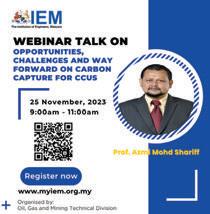

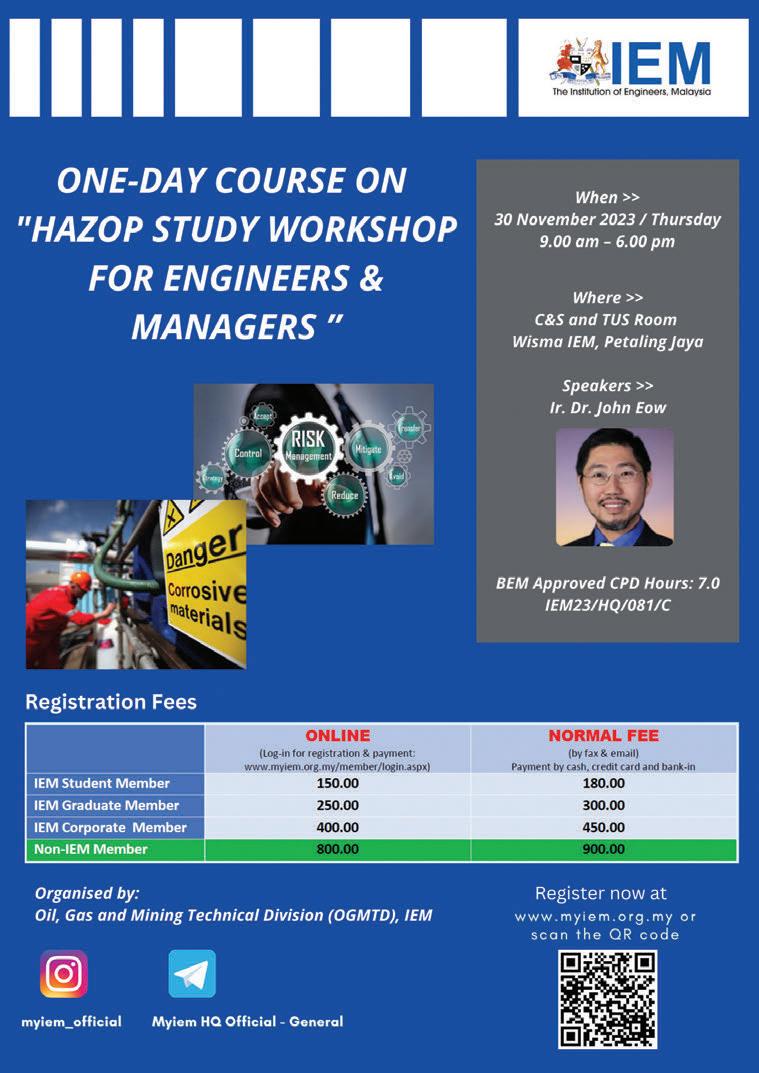
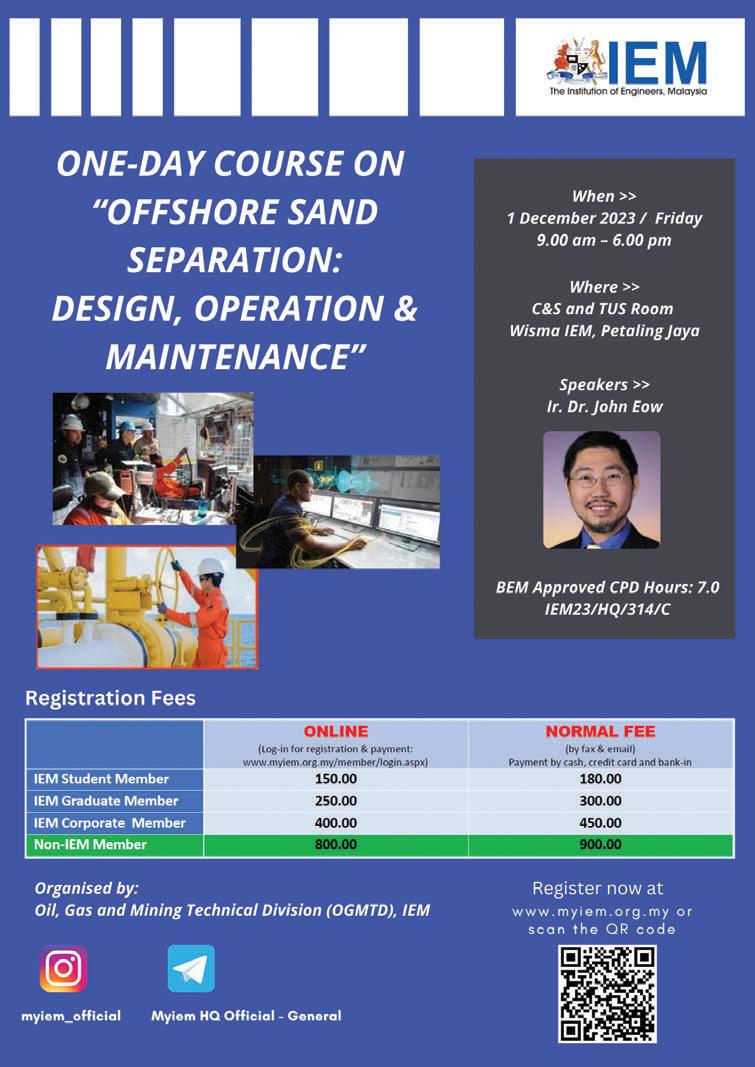
Yes! I would like to be a subscriber of The Institution of Engineers, Malaysia’s publications
Name: _________________________________________________________________________________________________________
Mailing Address: _________________________________________________________________________________________________
Company/Institution: ______________________________________________________________________________________________
Telephone
New Subscriber Renewal
Please commence my subscription from: _________________________(month/year) Signature: _______________________________
To start your subscription of IEM’s publications, complete this form and mail it back to the address below. For faster processing, fax it to: +603 7493 1047. Thank you.
What is your primary job title?
Corporate Management (including chairman, president, proprietor, partner, director, vice president, general manager, division manager, import/export manager, other corporate title)
Management (including project/contract/equipment/service/transport district manager, clerk of works, other technical or operating manager)
Engineering/Design (including chief engineer, chief designer, civil/ highway/mechanical/planning engineer, other engineering/design title)
Buying/Purchasing (including chief buyer, buyer, purchasing other buying/purchasing title)
Titles allied to the (architect, consultant, surveyor, research and development professor, lecturer, supervisor, superintendent, inspector or other allied title)
Others (please specify) ____________________________
What type of organisation do you work in? (Tick one box only)
Contractor
Sub-contractor specialist
Design and build contractor
Consulting engineering/architectural/quantity surveying practice
Mining/quarrying/aggregate production company
Petroleum producer
International/national authorities
National/regional/local government
Public utilities (electricity, gas, water, deck and harbour, other)
Manufacturer
Distributor/importer/agent
Construction department of large industrial/Commercial concern
Association/education establishment/research
Construction equipment hire/rental company
Project/construction management consultancy
Others (please specify) _______________________________
What are the main activities of your organisation? (Tick all that apply)
Constructions of: Manufacturer of:
Roads/bridges

Construction equipment
Dams/reservoirs/irrigation Cement structures Other construction materials
Foundations/tunnels
Structures/steel work
Distribution
Construction equipment
Construction materials
Building (commercial, industrial) Hire/rental of construction equipment
Housing Design
Construction management Earth-moving/open cast mining
Deep mining Aggregate production
Others (Please specify) _________________________________________
Rate (Please tick)
RM360.00 - 12 issues of JURUTERA
RM84.00 - 2 issues IEM Journal (Half-yearly)
Terms and Conditions:
1) The subscription is to be prepaid.
2) Please make cheque payable to Dimension Publishing Sdn. Bhd.
3) Subscriptions are not refundable.
4) Magazine/s will be sent to the mailing address given.
5) Students are entitled for a 20% discount from the above subscription rate.
6) Students must submit a photocopy of the student card together with the payment.
7) The above rate is inclusive of delivery charges and applicable in Malaysia only.
8) Additional delivery charges will apply to overseas subscribers.
For subscription enquiries, please contact +603-7493 1049 or email to info@dimensionpublishing.com











